Alaska
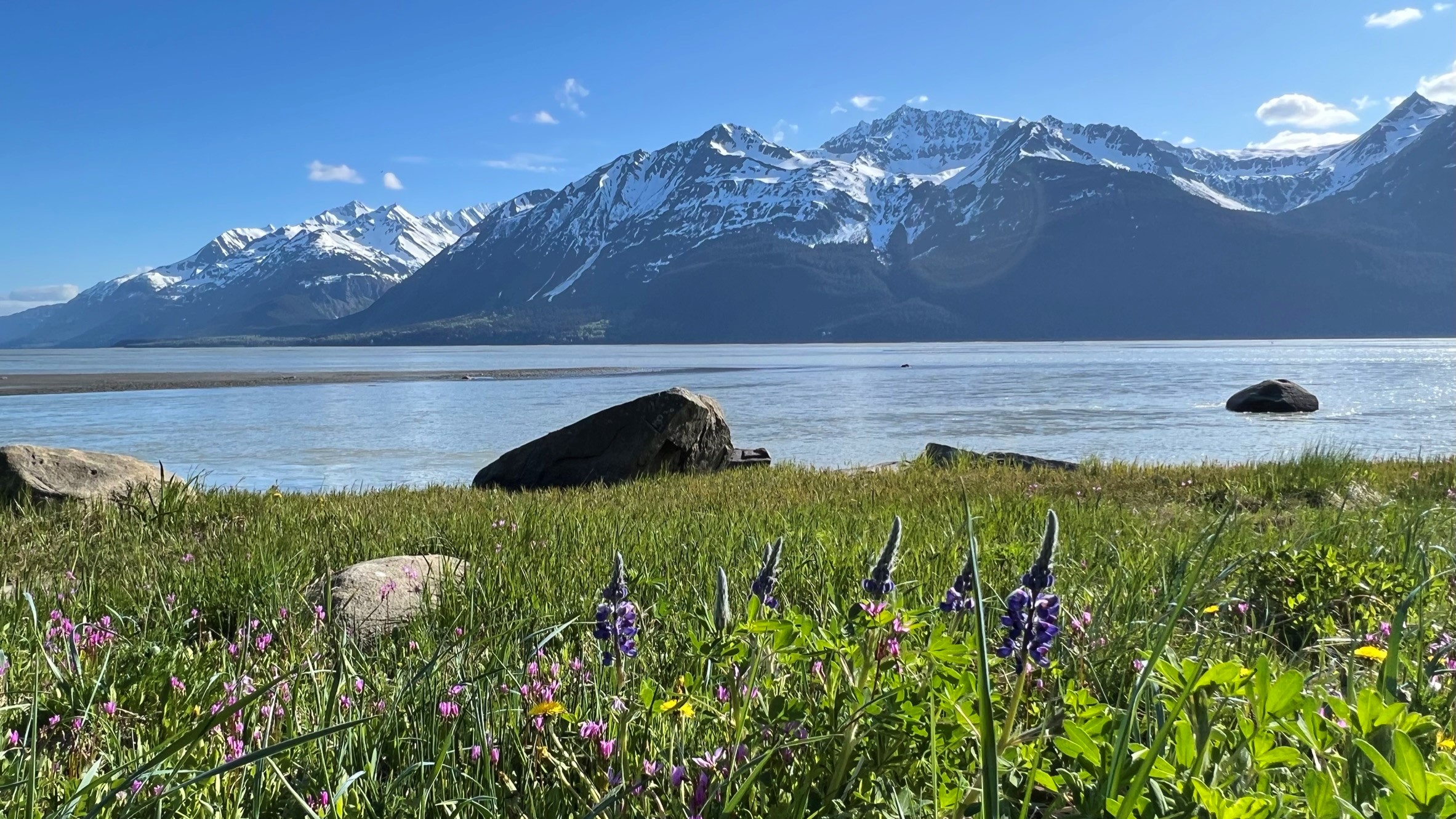
After my exchange semester at the University of Illinois at Urbana-Champaign I was traveling through the Fjords and National Parks of Alaska. I explored the state from Juneau in South-East Alaska to the Denali National Park in the center of the state. In this report I want to share my experiences with stunning landscapes and abundant wildlife.
Table of Contents
- South-East Alaska
1.1. Juneau
1.2. Haines
1.3. Skagway - Anchorage
- Denali National Park
- Kenai Peninsula
4.1. Homer
4.2. Seward
4.3. Whittier and the 26 Glacier Cruise
1. South-East Alaska
Starting my tip in Chicago, I flew into Juneau, the capital of Alaska. From there I took a ferry to Haines and Skagway.
1.1 Juneau
Even though Juneau is the capital of Alaska it is only accessible by plane or boat, there are no roads connecting it to the rest of North America. The city is in the south-east of Alaska and is surrounded by mountains and glaciers. For two nights I stayed in the Juneau Hostel very close to Downtown. In my opinion, one day in Juneau is enough.
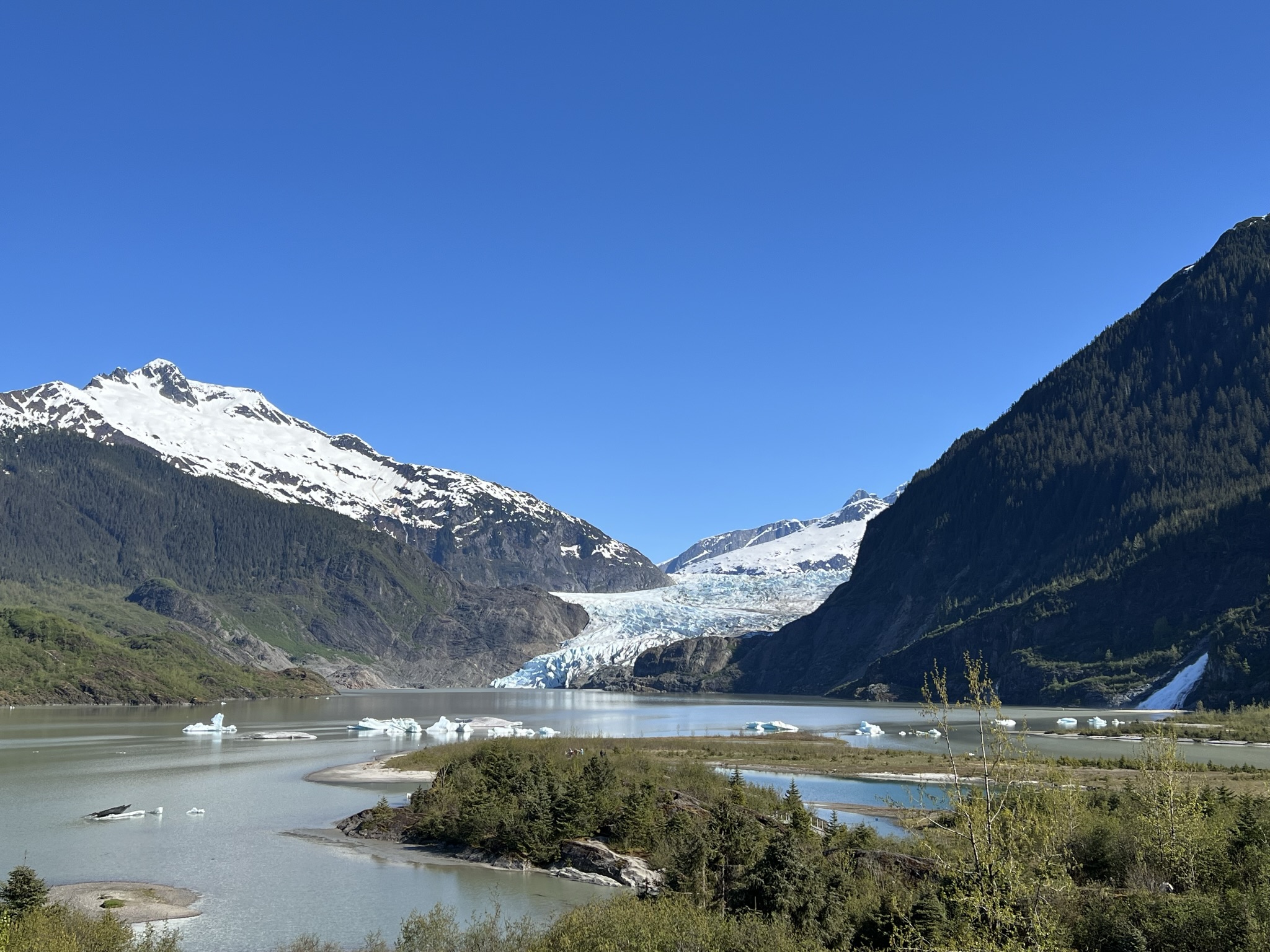
Mendenhall Glacier

Nugget Falls
Located just outside the city, the Mendenhall Glacier is a popular tourist destination. As all glaciers in the area, it is part of the almost 4000 square kilometer Juneau Icefield that stretches from the city to the border with Canada. In the area of the Mendenhall Glacier you can take a short and easy hike along the lake in front of the glacier finally reaching the Nugget Falls. The hike is very popular and you will meet many other tourists on the way. If you want to get away from the crowds you can take the longer East Glacier Trail that goes through the moderate rainforest (Brochure).
After hiking the Nugget Falls Trail and the East Glacier Trail, I was picked up by a bus that took me to a whale watching tour. It did not take us long to find the first sea lions and humpback whales. The whales were feeding on krill and were very active. To find them, you look for blows coming out of the water. It was also very interesting to learn about their habits, for example that they take approximately 7 breaths before they show their back and then their tail before diving down.
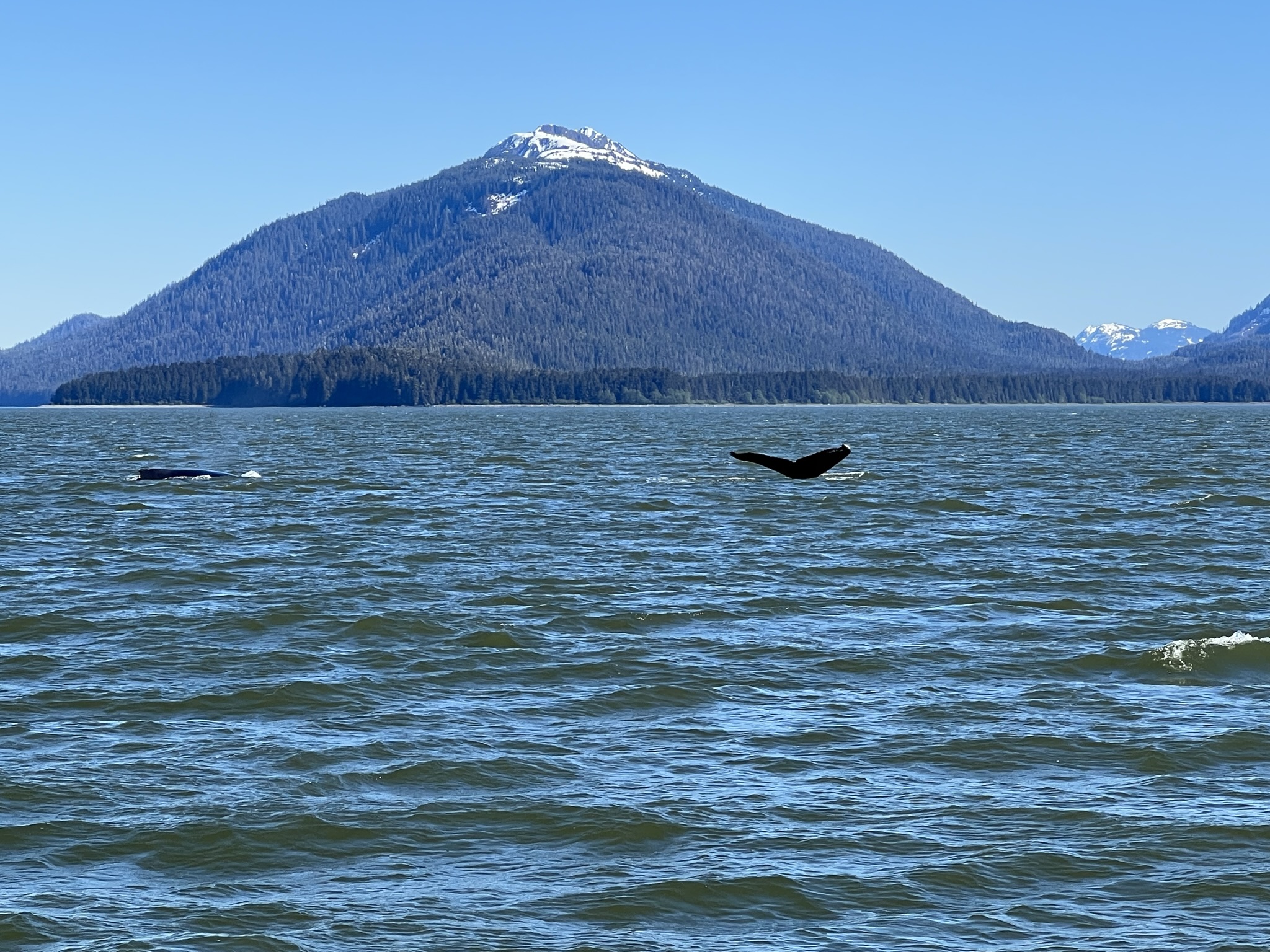
Humpback Whale Fluke
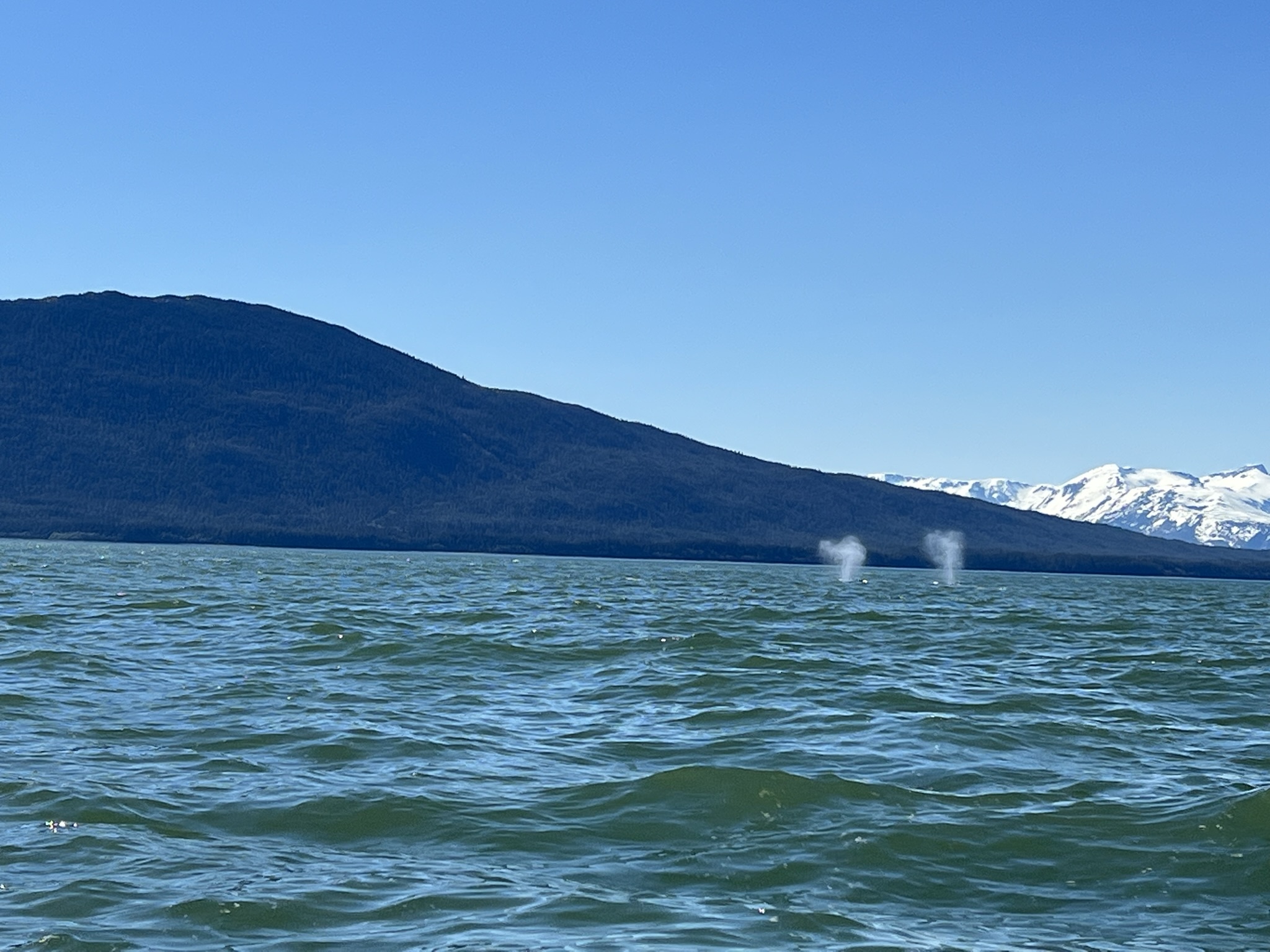
Humpback Whale Blow
1.2 Haines
From Juneau I took a ferry of the Alaska Marine Highway System to Haines. The ride took about 4 hours and led through a scenic fjord with white glaciers and snow-capped mountains. In Haines I went on a raft tour on the Chilkat River. After a short introduction we were ready to go. In the beginning the river was very calm and we could enjoy the beautiful scenery. After a while the river became wilder and we eventually hit a tree that was stuck in the stream. After a bump on the front of the boat we were still fine but when we hit the tree with the back of the boat we capsized. At first only the people in the back went over board since this part went under the tree (our boat had now an eight-shape). Then another boat was pulled over to rescue the rest of us but after one person jumped into the rescue boat we finally flipped over completely. I can tell you: glacier water is really cold. Luckily there where three other boats with experienced rafters that could help us. Also, all the boats have chests with dry clothes.


One of my biggest goals in Alaska was to see a bear. In Haines there is the Chilikoot Lake with a small river to the sea that is a popular spot for bears that hunt for salmon there. For this reason I drove the road next to it up and down to find a bear but I didn't have any luck, probably also because the salmon was not running yet.
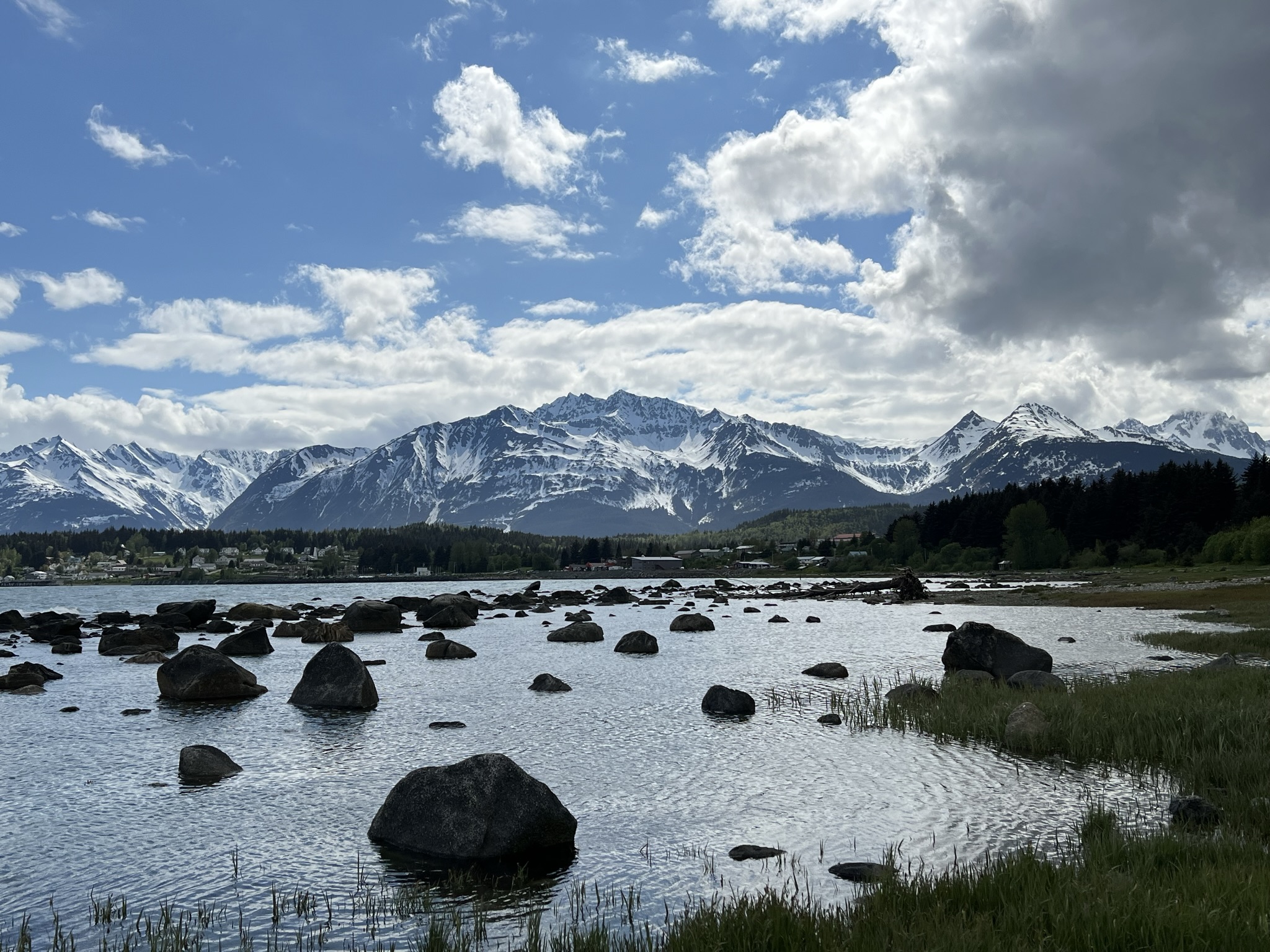
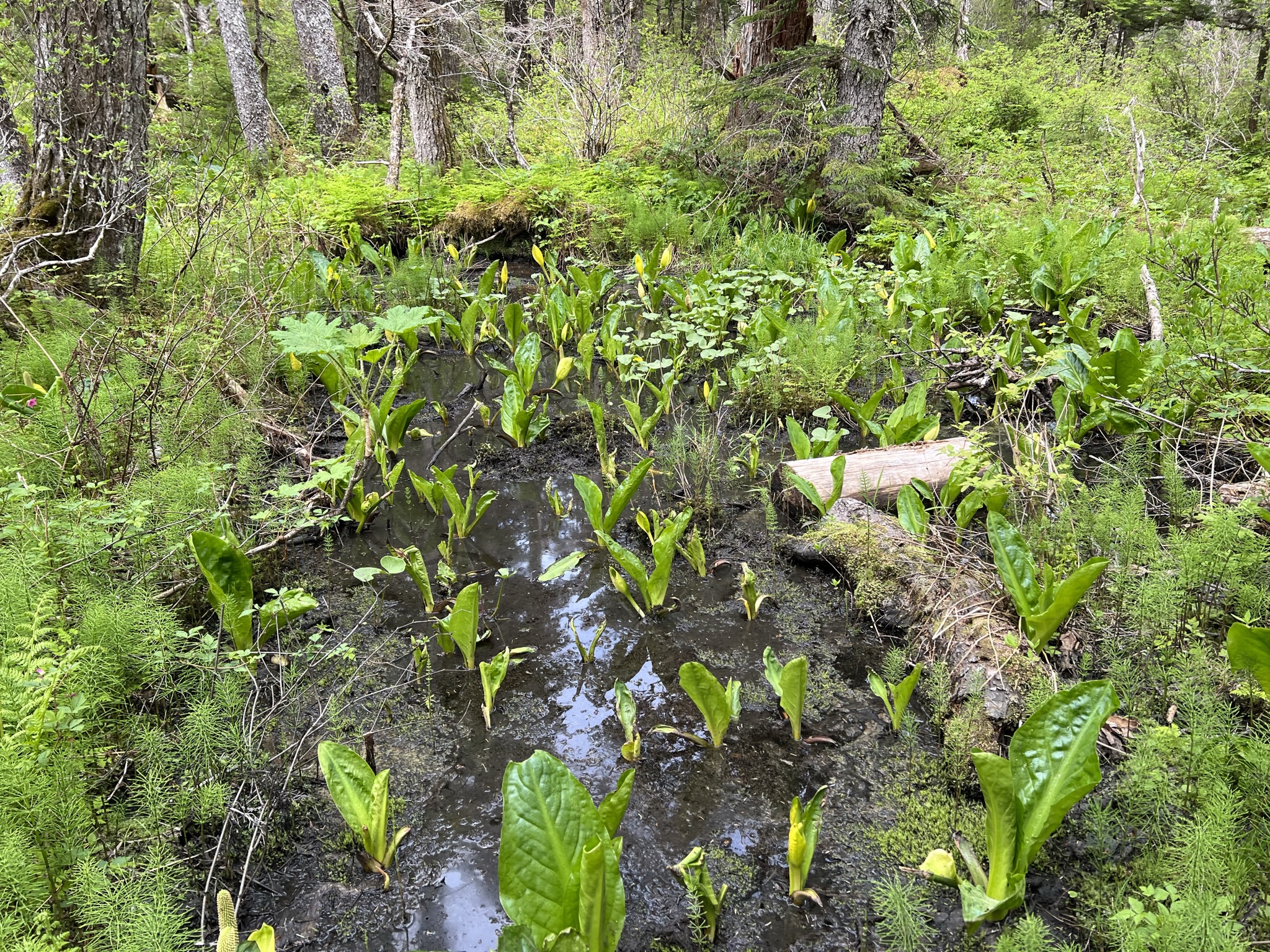
Two other activities I did in Haines were fishing and hiking. Along the shore and in the harbor, I was able to catch Rockfish, Flunders and Dolly Varden. Latter is a trout species with red meat that is very tasty. The hike I did was in the Chilkat State Park. It led through the temperate rainforest but also along the coast with a beautiful view of mountains and glaciers.
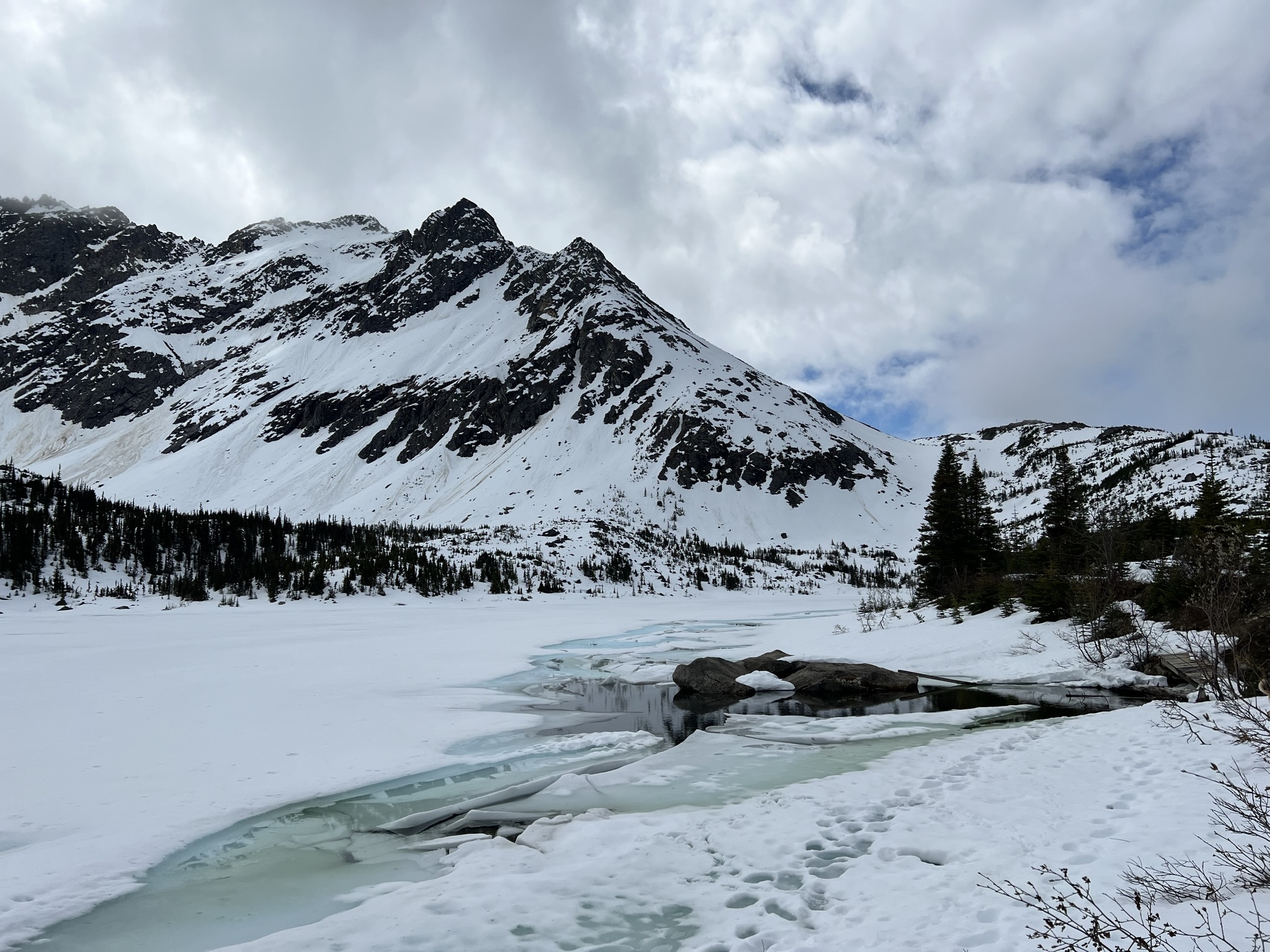
Upper Dewey Lake

Creek coming from Upper Dewey Lake
1.3 Skagway
On one day I took a ferry from Haines to Skagway for a daytrip. The ride took about 1.5 hours and was very scenic. Skagway is a small town at the end of the fjord with about 200 residents who stay there year-round. During the summer months the population increases and the down gets flooded with tourists from cruise ships. I spent my day with hiking to the Upper Dewey Lake. The trail starts in the city and leads through the forest up to the lake. The hike is very steep and you gain about 800 meters in altitude. The lake is located in a beautiful valley with a view of the surrounding mountains. Since I was there in late May, the hiking trail was still covered in snow for half the way (which I was not prepared for). Sometimes you also heard or in some cases even saw that there was water flowing under the snow you were walking on. The lake was also still frozen and covered in snow but the view was stunning. On the way back I took the Lower Dewey Lake Trail that leads along the lake and through the forest back to the city. I also hiked to the Icy Lake and the Upper Reid Falls.
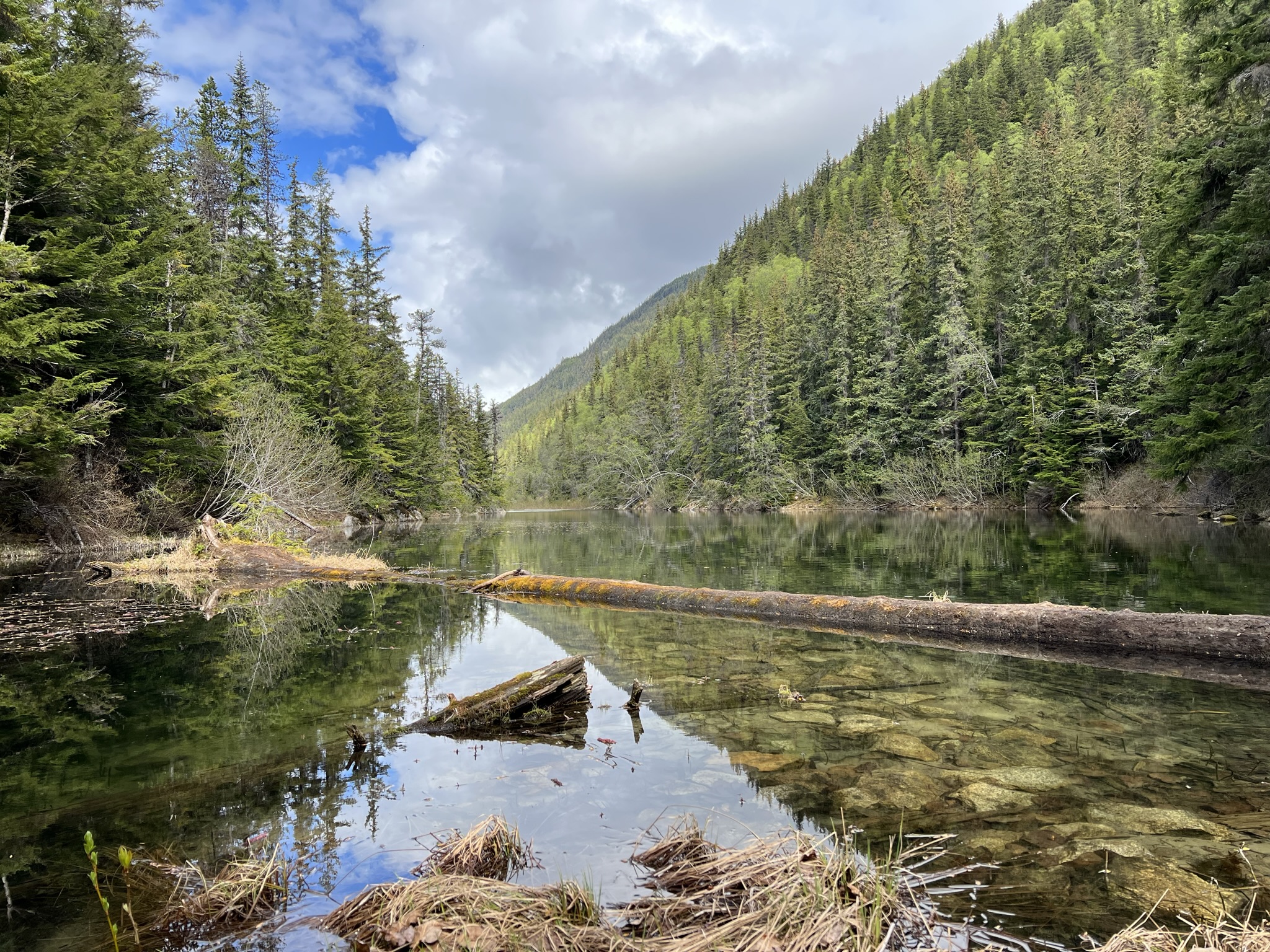
Icy Lake
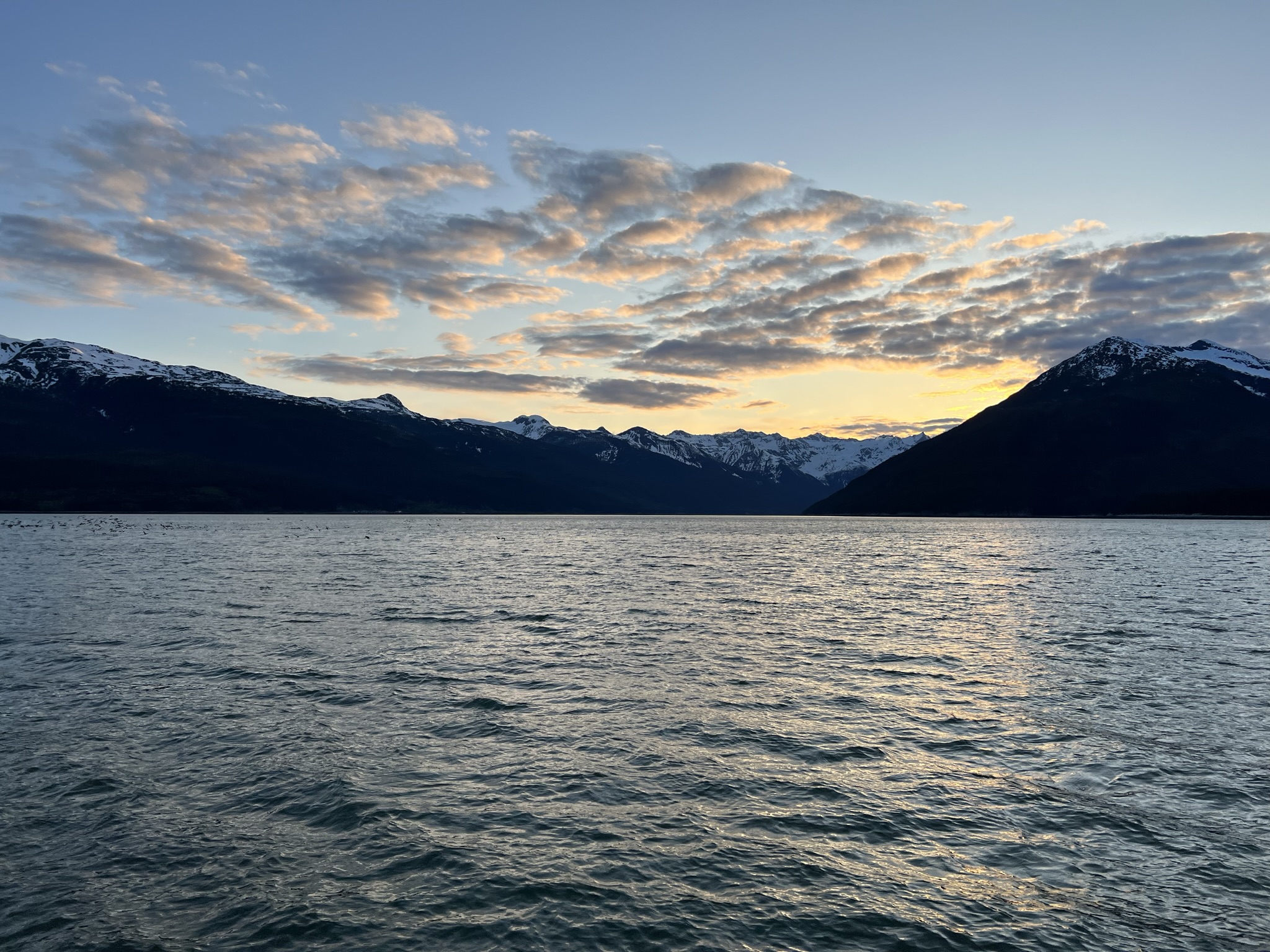
Sunset on Ferry from Skagway to Haines
After staying in South-East Alaska for about a week I wanted to go to Central Alaska. Therefore, I had to go back to Juneau to catch a flight to Anchorage. This time I did not take a ferry of the Alaska Marine Highway System but a boat that was a combination of ferry and wildlife viewing. During the ride we saw dozens of bald eagles sitting in the trees along the shore, sea lions lying on the rocks or swimming close to them and even a few humpback whales.
2. Anchorage
Anchorage is the largest city in Alaska with about 300,000 residents, which is nearly have the population of Alaska. It is located in the south-central part of the state and is surrounded by mountains that give the city (that is not very pretty) a very unique atmosphere since you can see them from basically everywhere. I stayed at the Base Camp Anchorage Hostel, a nice place 20 minutes from Downtown (by foot). There is a bus stop right next to it with connections to Downtown and the airport. A day ticket for public transport is only five dollars. As I did not have a car, there was only a very limited number of activities I could do. Along the shore there is the Tony Knowles Coastal Trail that leads from Downtown to Kincaid Park. It is a very nice walk with a view of the mountains and the sea and I was able to see my first moose. Probably because they are very used to people, moose in this area come really close, but as I learned later, they are more dangerous than baers and really chase people in some cases. One of the prettiest building in Downtown is the Visitor Center, a log cabin. It is located on the main street of Downtown, the 4th Avenue, that is also home to many souvenir shops. In the city there also is the Anchorage Museum that is worth a visit. It has a lot of information about the history of Alaska and the native people.
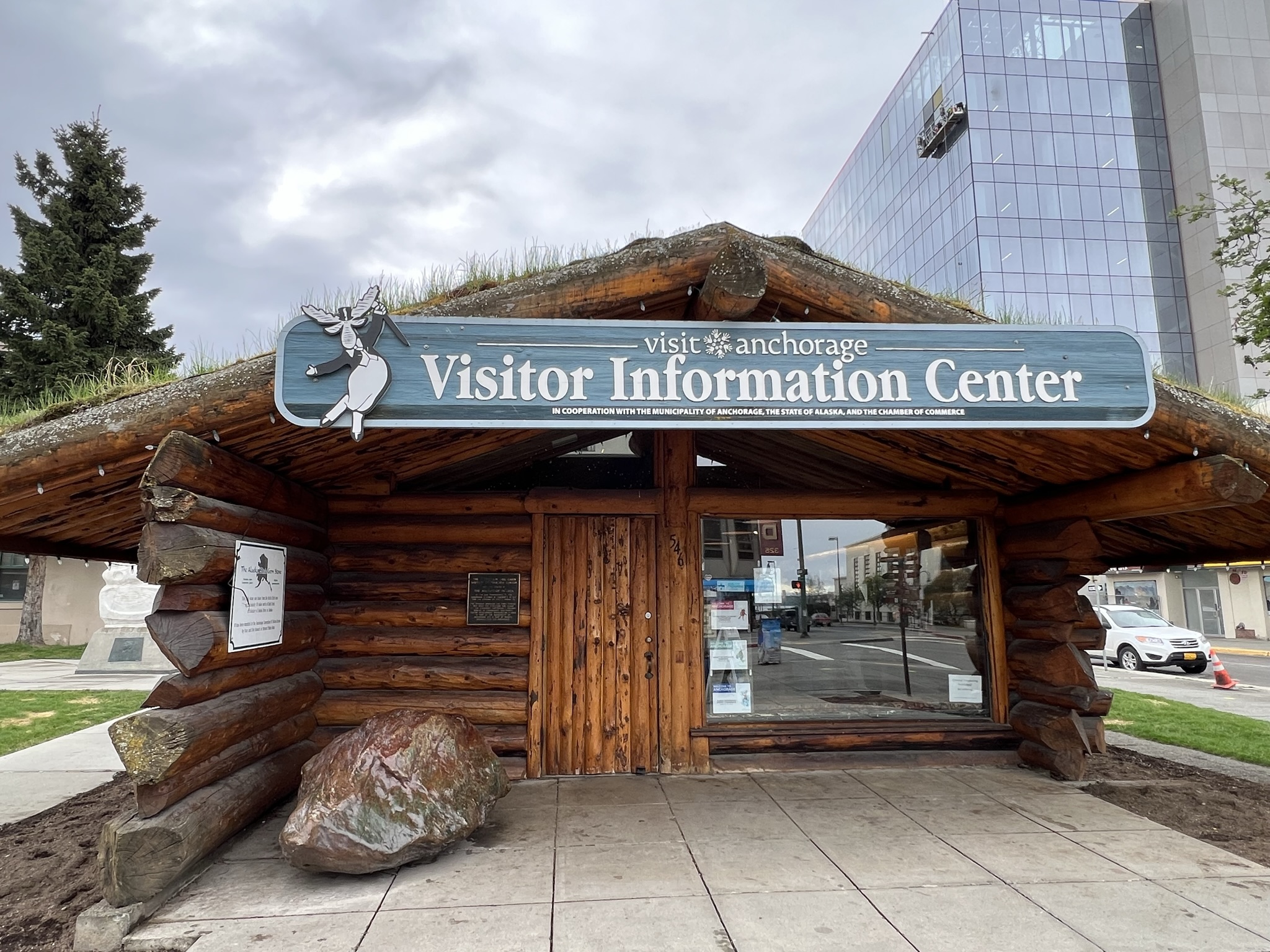
Visitor Center Anchorage
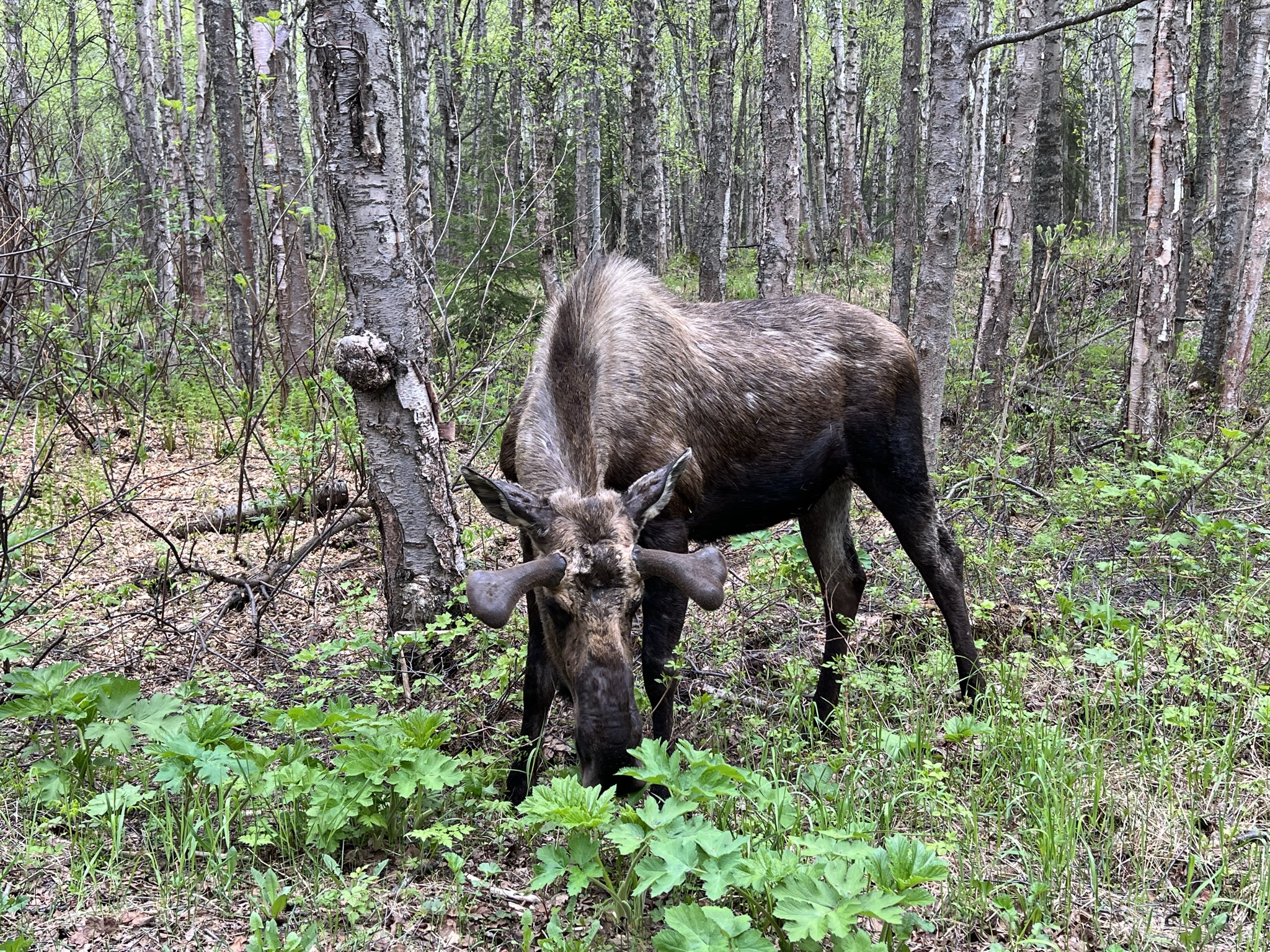
Moose on the Tony Knowles Costal Trail
3. Denali National Park
My next stop was the Denali National Park. It is located in the center of Alaska and is home to the highest mountain in North America, the Denali (formerly known as Mount McKinley) and a large variety of wildlife. The park is about 240 kilometers long and 130 kilometers wide.
To get to the park I took the Denali Star Train from Anchorage to the Denali Depot. It was a scenic 8 hours ride through the mountains and along rivers. If you book the cheap Adventure Class, you can sit in the observation car that has large windows and a glass roof. In case you take the expensive class, the Goldstar Service, you also have an outdoor viewing platform. For some people living along the tracks the train is the only way to get to the next city.
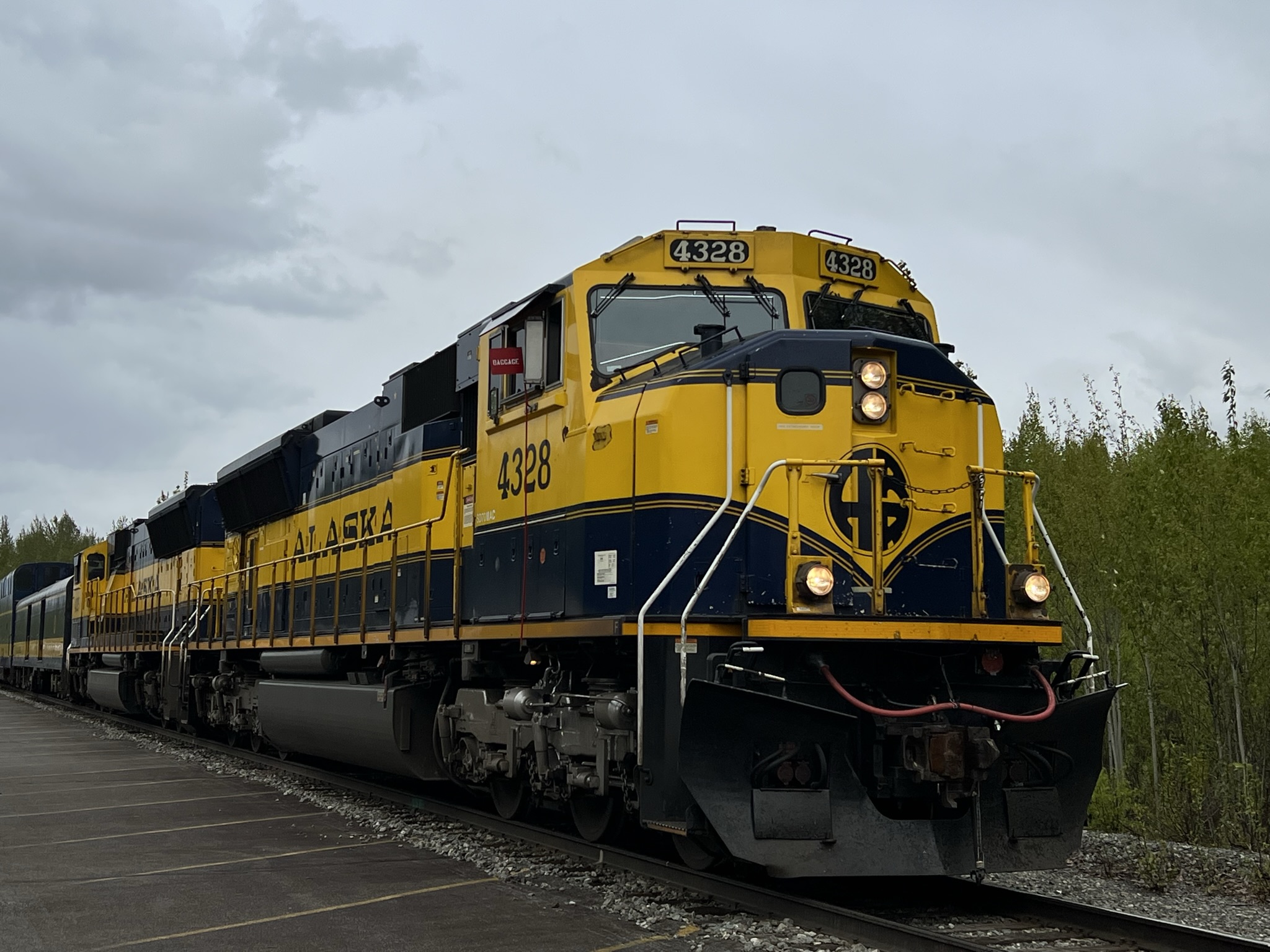
Alaska Railroad Train
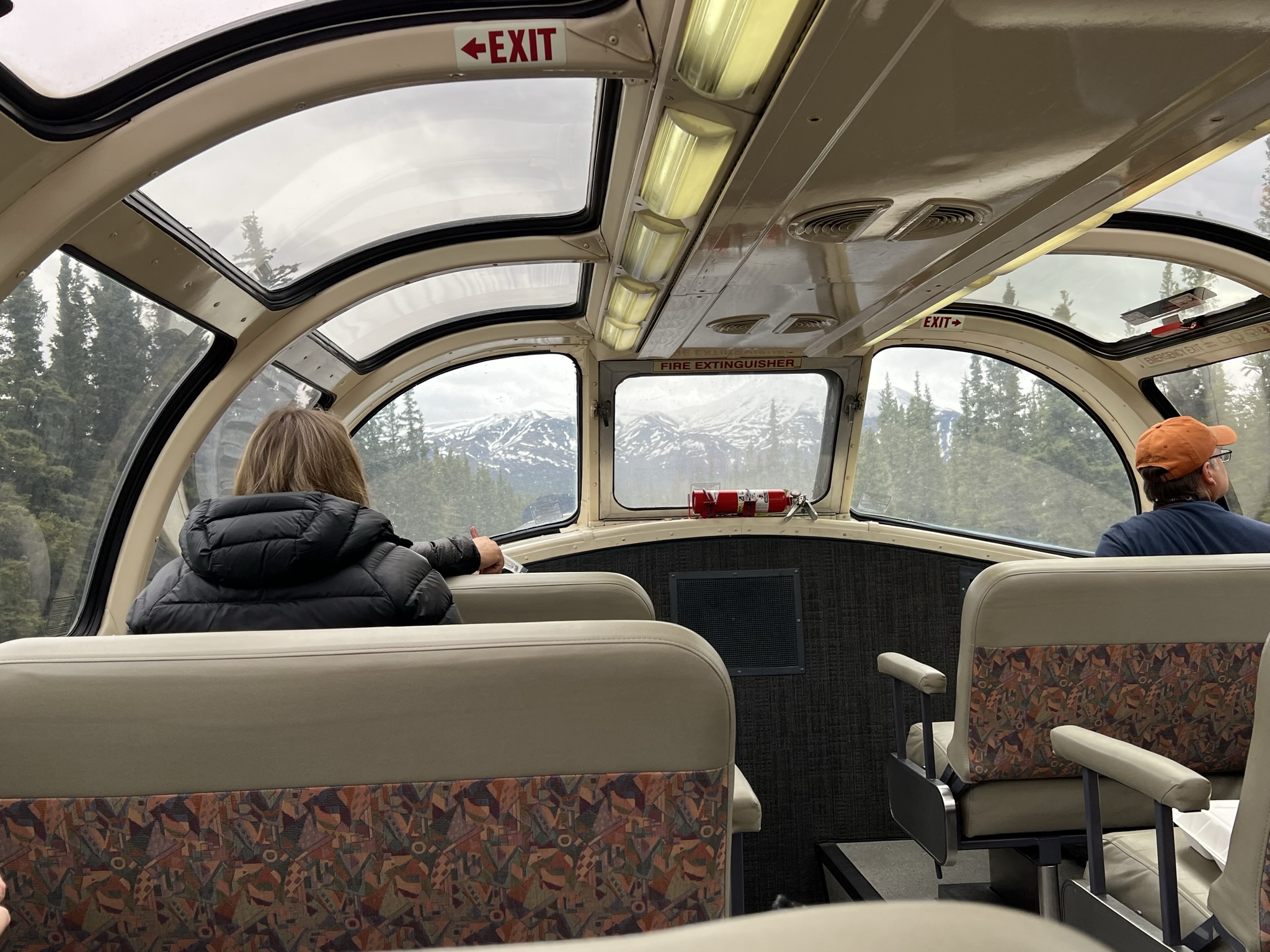
Observation Car
I stayed at Denali Hostel & Cabins which is located 15 miles from the park entrance. In the hostel I did not stay in a dorm room but in a canvas castle that comes with a camp bed and a sleeping bag. It was also equipped with a lamp but since the sun did not set before I went to bed (midnight), there was no need for it. Even though the temperatures got quite cold at night (4°C) it was warm and cozy - only leaving the warm sleeping bag in the morning was hard. The only bad thing about the hostel is that there is only one shuttle going from the hostel to the park that is $27 per ride.
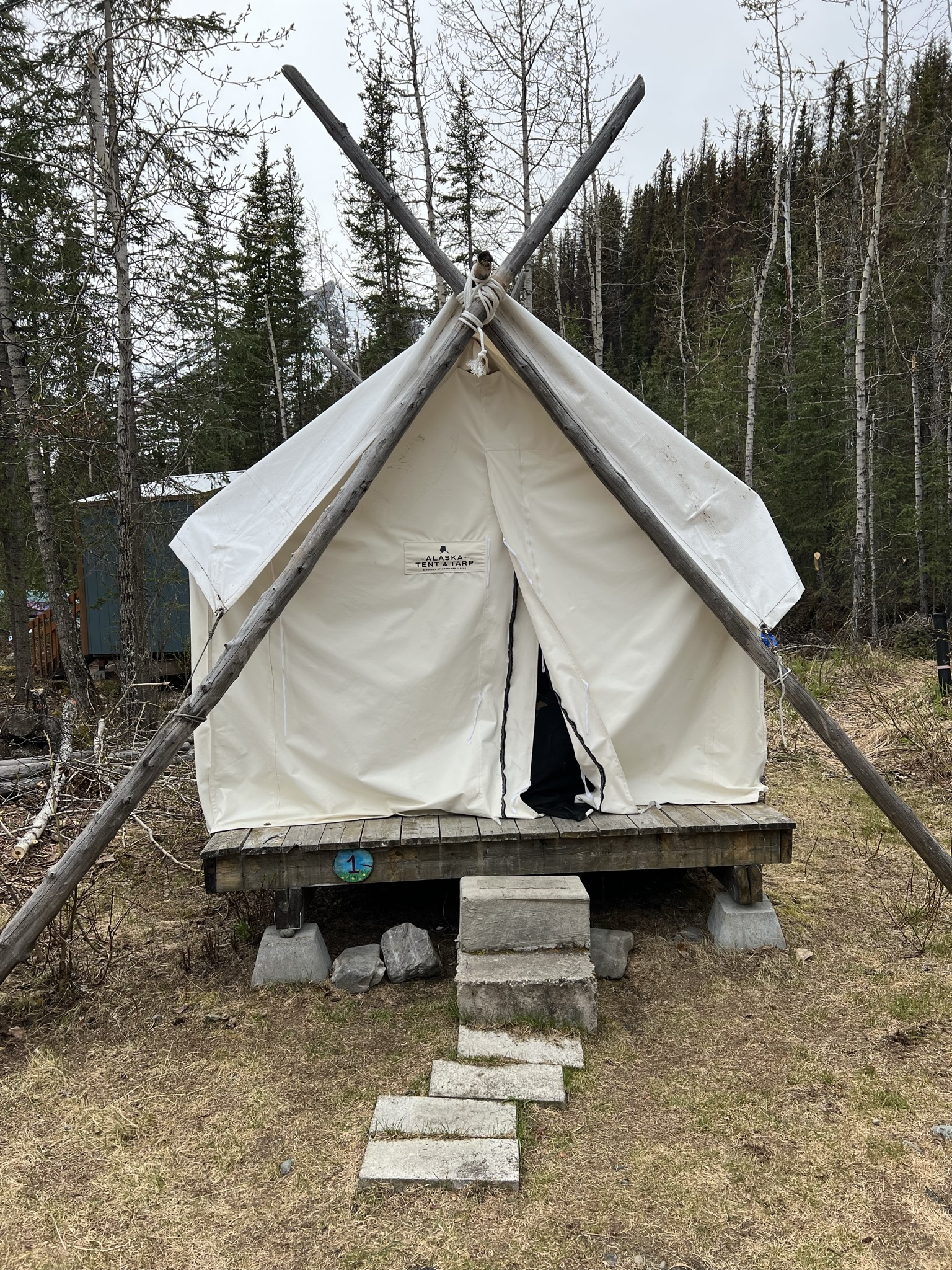
Canvas Castle

Park Entrance
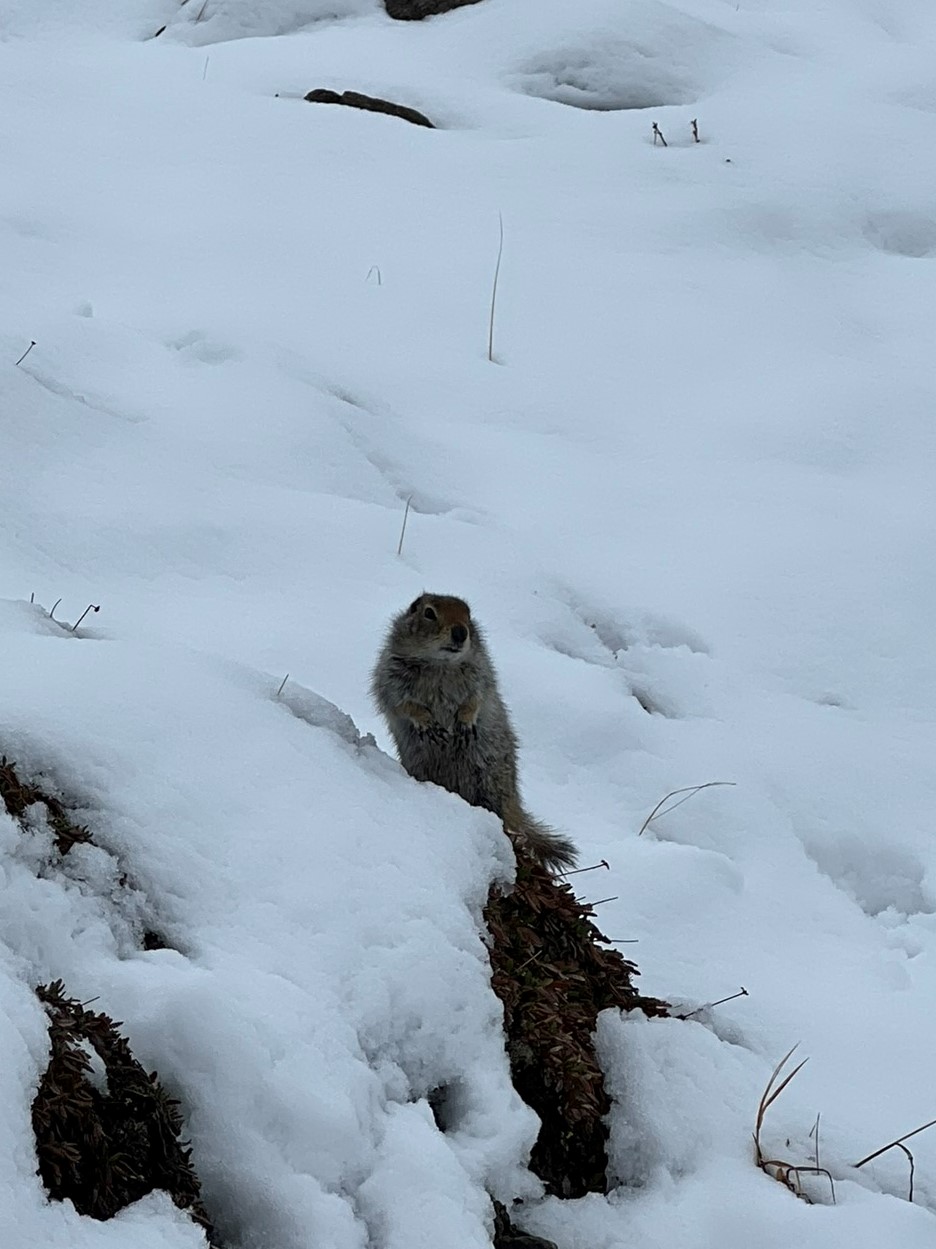
Ground Squirrel
On my first day in the park, I took the shuttle to the Visitor Center and hiked some trails in this area (Maps). I started with the Mount Healy Overlook Trail that leads up to a viewpoint with a beautiful view of the valley and the mountains.


Then I hiked the Horseshoe Lake Trail that leads through the forest and around a lake that is home to beavers who built an enormous dam. I was also lucky enough to spot a beaver swimming in the small river behind the dam but unfortunately it was too far away for taking a photo. I could only see it through my binoculars (that are a must-have in Alaska). My last trail of the day was the Rock Creek Trail that leads along a small river and through the forest.
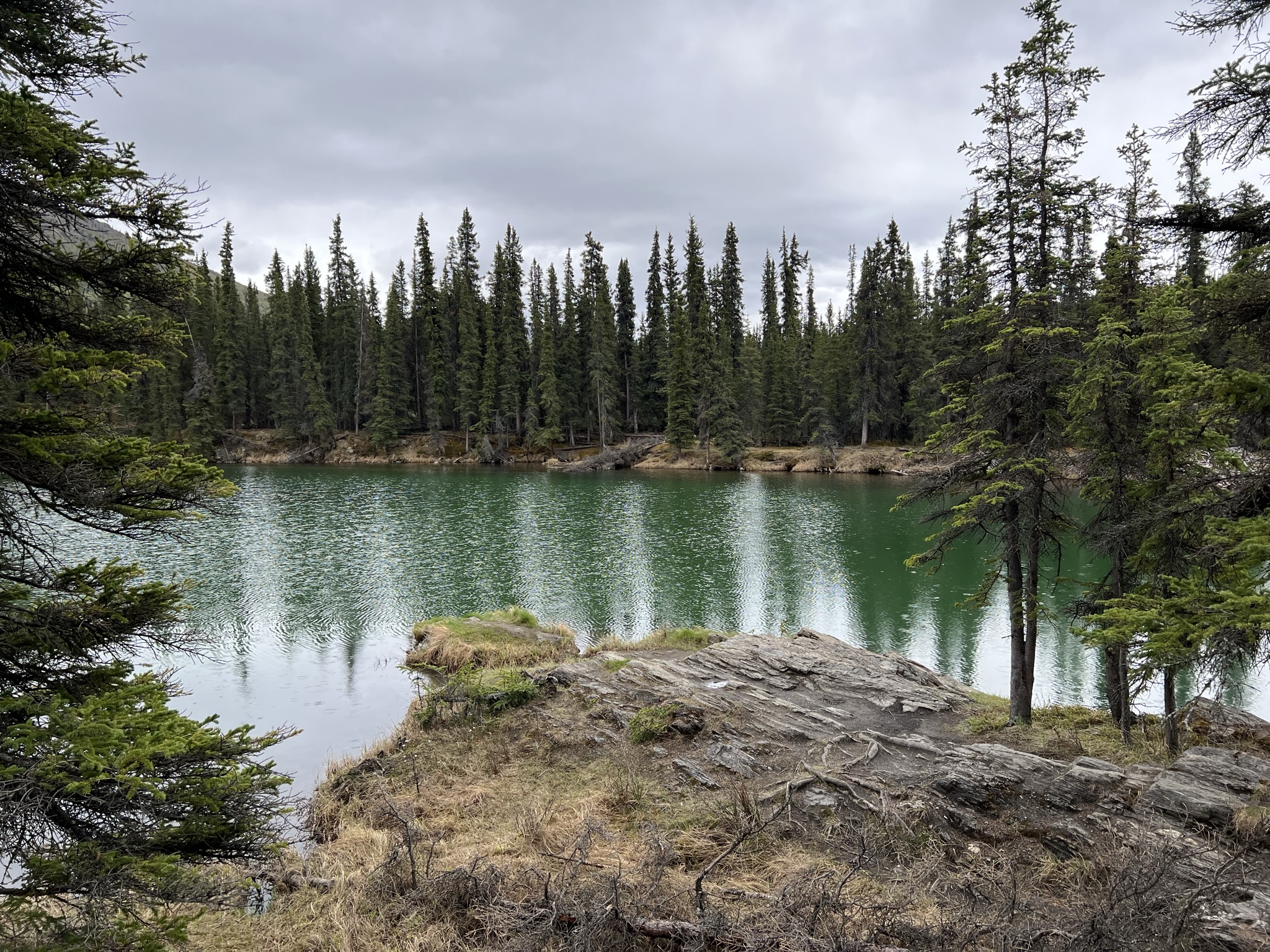
Horseshoe Lake

Beaver Dam
There is only one road in the park that is 92 miles long but there has been a land slide so right now it is only accessible until mile 43 (and apparently the road will not be fixed until 2026). Taking your own car to get into the park is only possible until the Savage River (mile 15). To get further into the park you must take a bus. There are two types of buses: the transit bus and the tour bus. The transit bus is $32.75 (as of May 2023) per person. It allows you to get off at any point during the ride and will pick you up at any point as well. If someone spots animals and shouts it at the driver he will stop and you can take pictures. The tour buses have more narration and are more expensive - I did not take it but I believe it is not worth it since the drivers of the transit buses do also narrate. Depending on the number of wildlife stops, the ride to mile 43 takes about 2.5 hours. The ride leads through different vegetation zones: forest, tundra, and taiga. The tundra is a unique landscape with small plants and flowers whereas the taiga is a forest with small trees. If you are lucky, I was not, and have a clear day it is also possible to see the Denali Mountain (Mount McKinley).
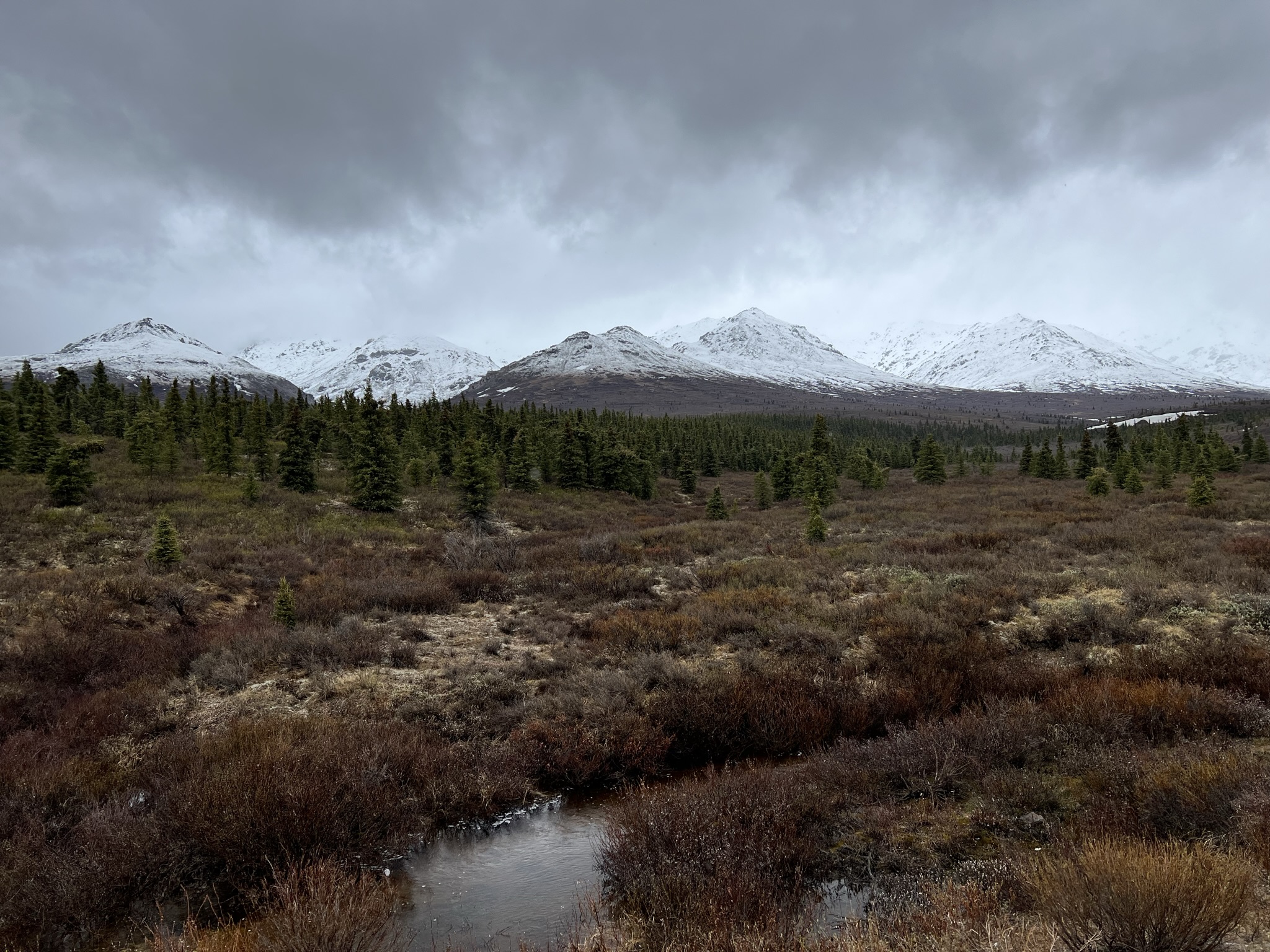
Taiga
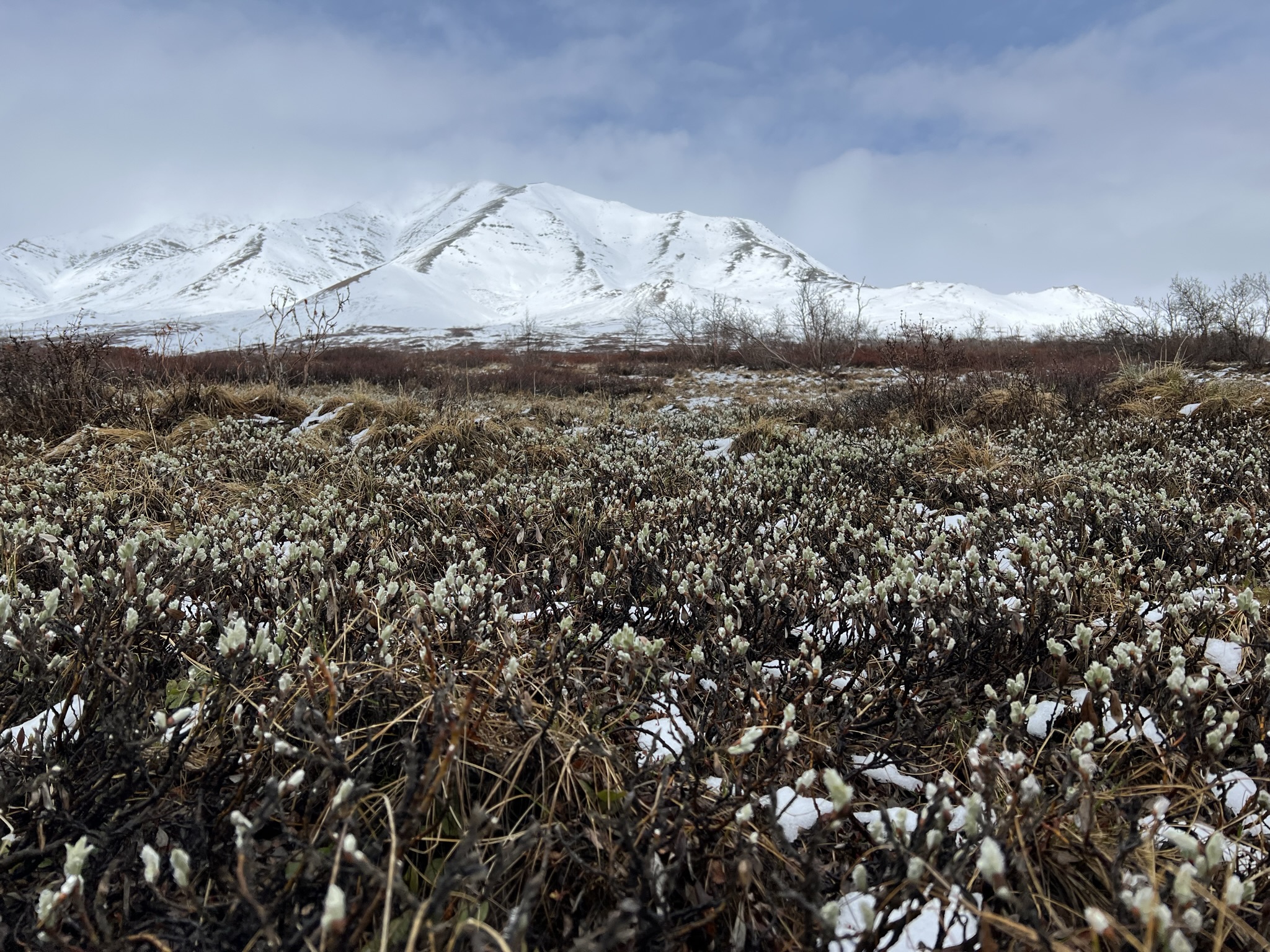
Arctic Tundra
My goal was to spot as many of the Denali big five (moose, caribou, bear, wolf, dall sheep) as possible. Riding the bus for the first time I was able to see moose, caribou and dall sheep. The dall sheep stay up in the mountains and only come down very rarely to cross a valley. For this reason, it is very important to have binoculars to see more of them than just a white spot on rocks. Caribous however could be closer to the bus and are usually groups. Whereas the herd sizes in Denali a rather small, herds in other parts of Alaska can have up to 235,000 animals. I was also able to see some Willow Ptarmigan, the Alaskan state bird. Their plumage is white in winter for better camouflage and then turns brown in spring.
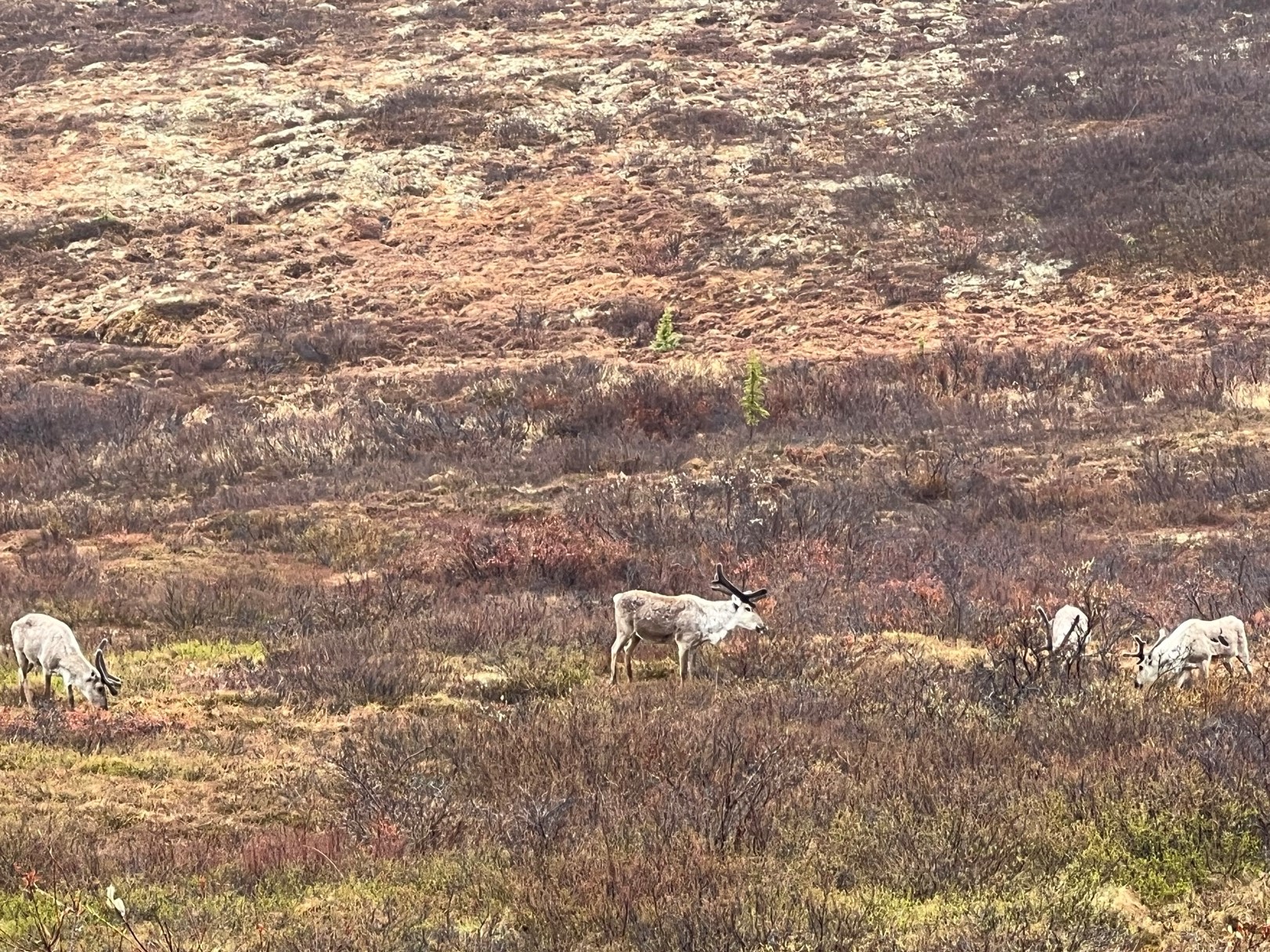
Caribou

Willow Ptarmigan
On the way back I dropped off the bus at mile 15 to hike the Savage Alpine Trail. It is a very steep but scenic trail that leads up to a viewpoint with a beautiful view of the valley and the mountains.

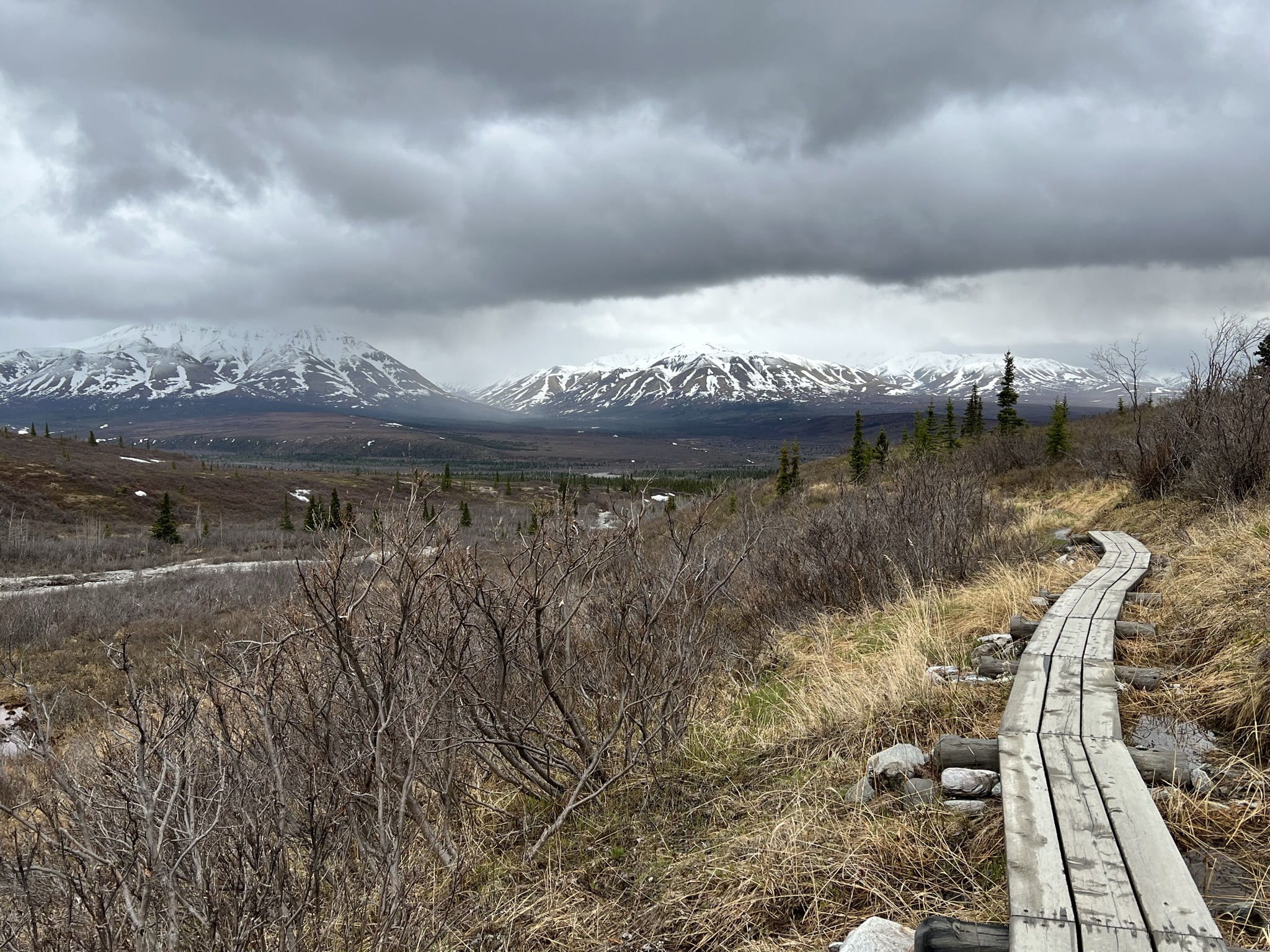

After finishing the hike, I walked along the street waiting for the next bus to pick me up. On the ride back we were able to spot some more caribou and a porcupine.
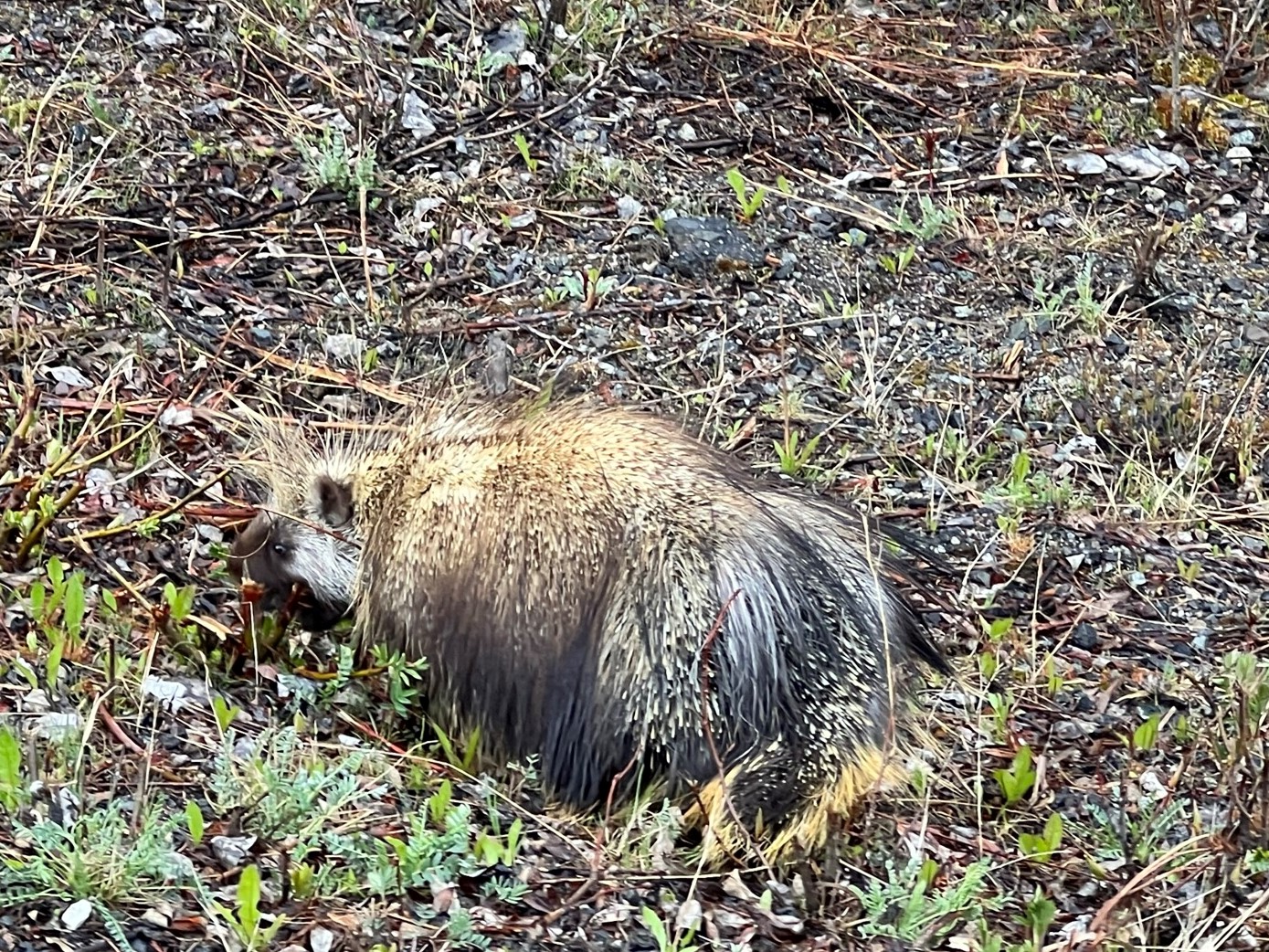
Porcupine
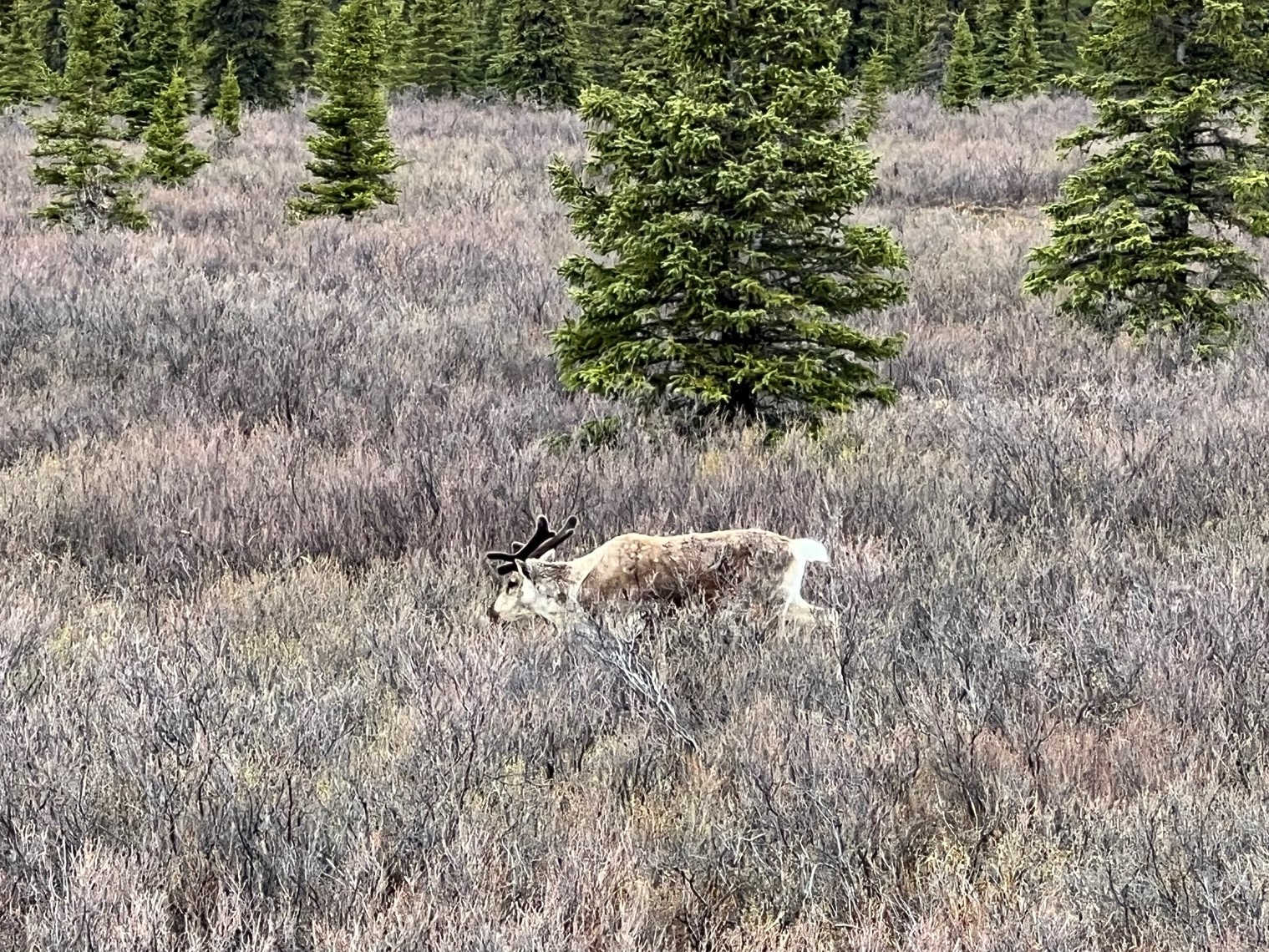
Caribou
In the park, there are only very few hiking trails that are not right next to the visitor center. For this reason, I wanted to do a ranger guided off-trail hike but unfortunately, they only offer this beginning in mid-June and I was there end of May. For this reason, I took the transit bus to mile 43 again to go hiking back there. During the bus ride, we were able to spot numerous moose, caribou, dall sheep and Willow Ptarmigan. And finally, after two weeks in Alaska, I was able to see a bear. It was a grizzly bear walking along a small river, about 400 meters away, in a valley along the road.
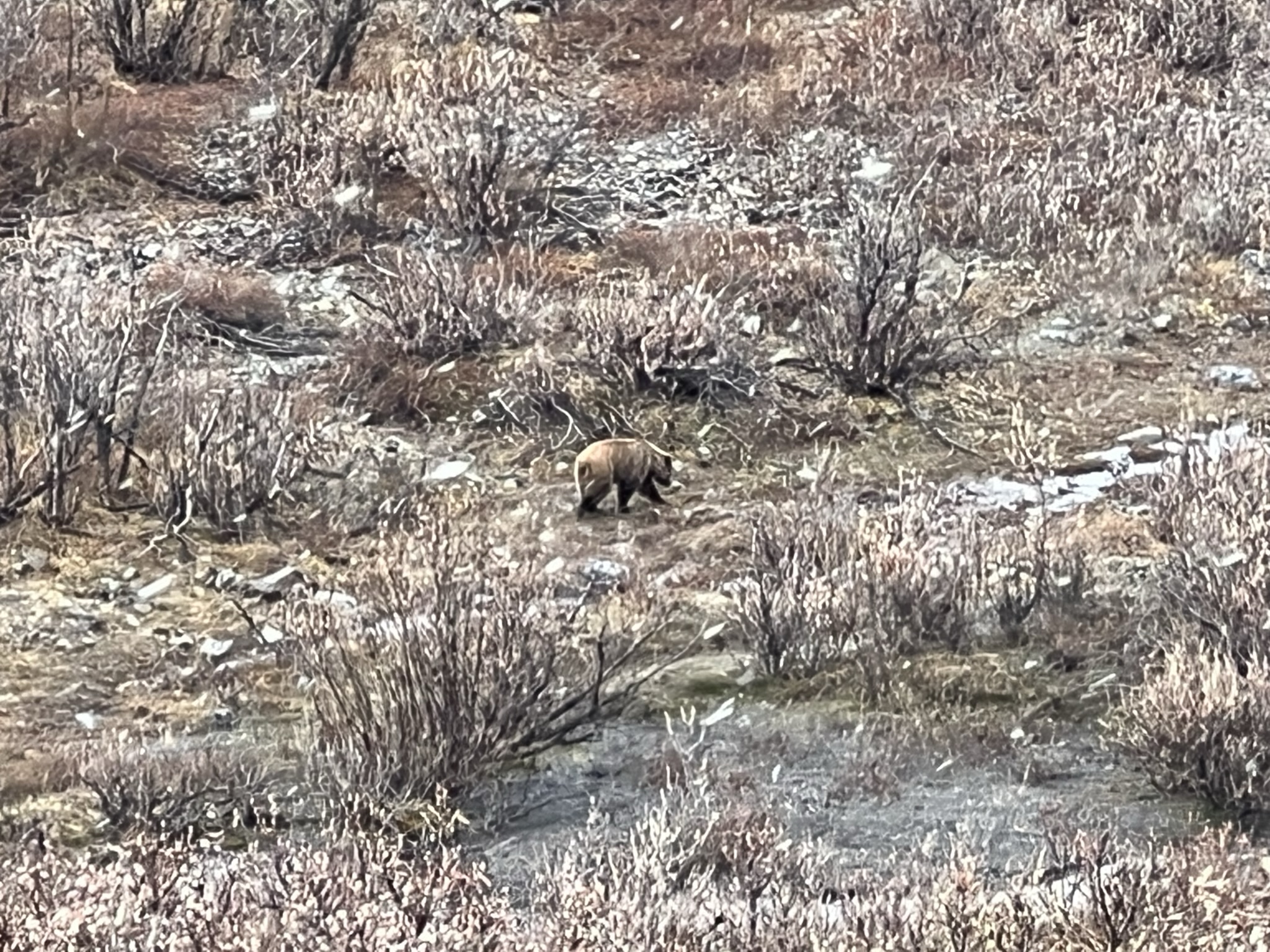
Grizzly Baer
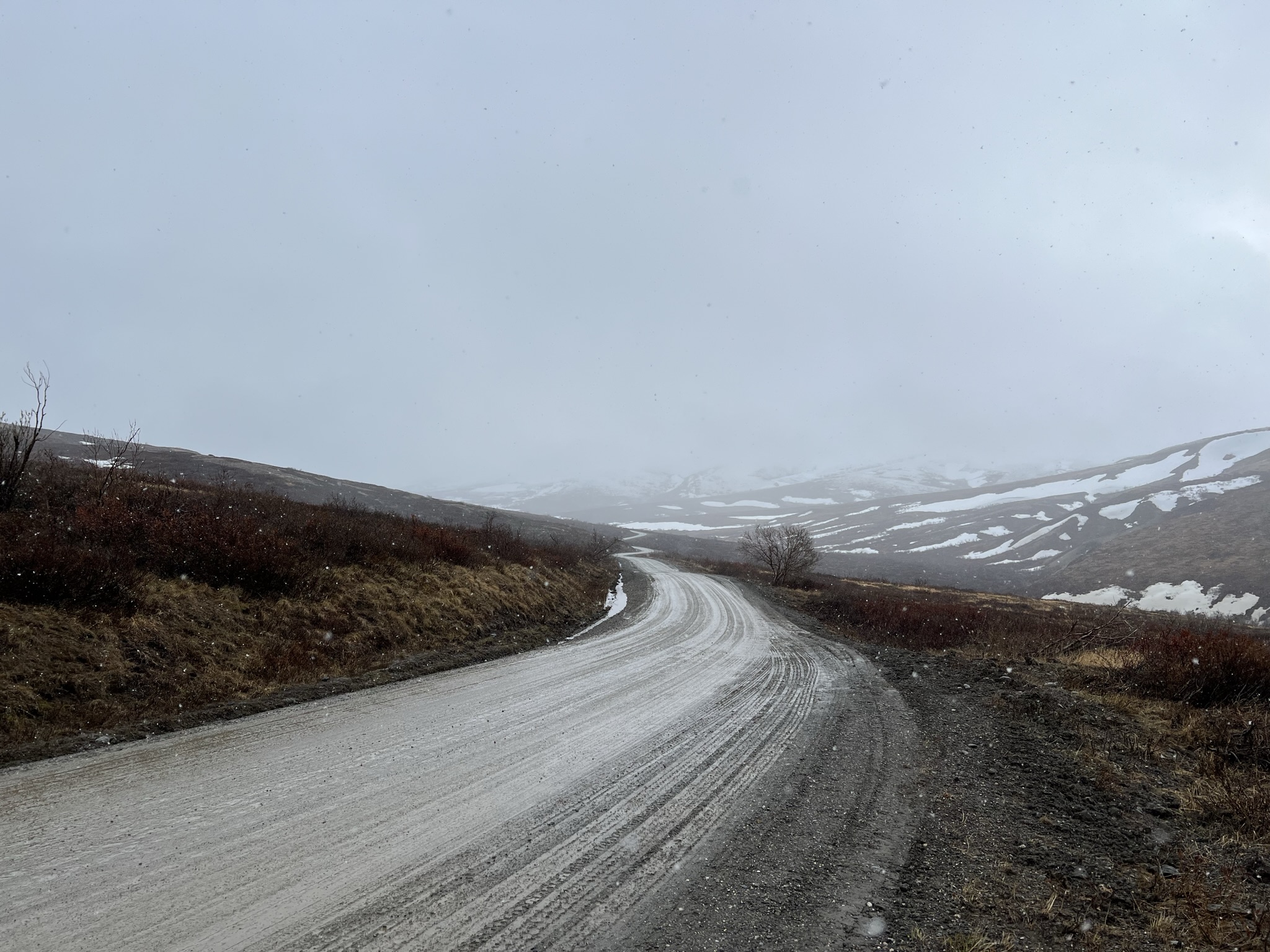
Road into the park
When we arrived at mile 43, two other guys I met in the park and I got off the bus to hike. We basically had two choices: hike along the gravel bars of a river or hike along the street back towards the park entrance. Since the weather was not very good, we decided to hike along the street to get an easy pickup (and maybe also because we wanted to see the bear again). While hiking, we were able to spot the bear again, but now it was even farther away. As a compensation we saw gold eagles circling above us. Moreover , we could enjoy the beautiful scenery of the valley and the mountains. After about 2 hours we were picked up by the bus again and drove back to the park entrance.
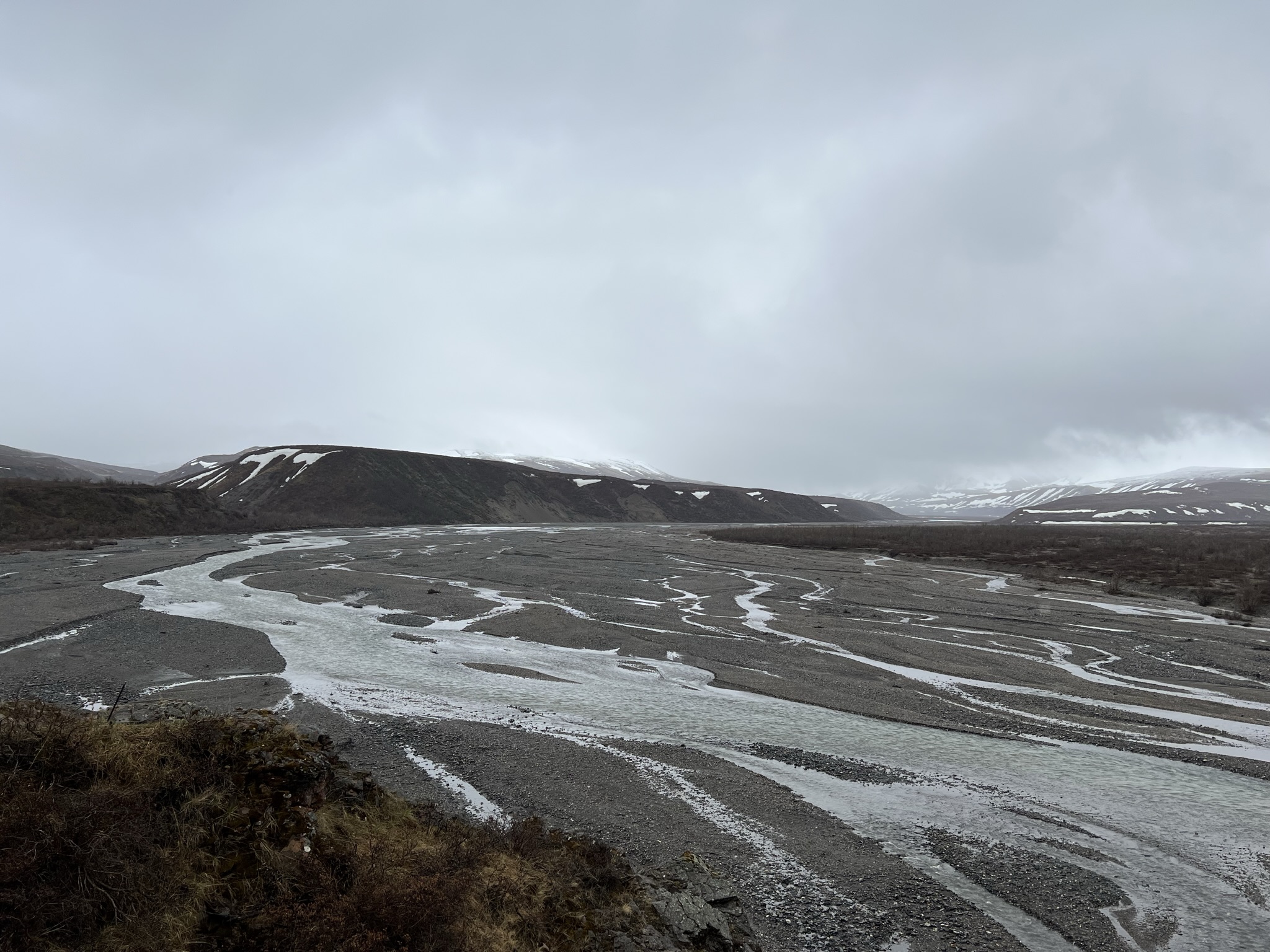
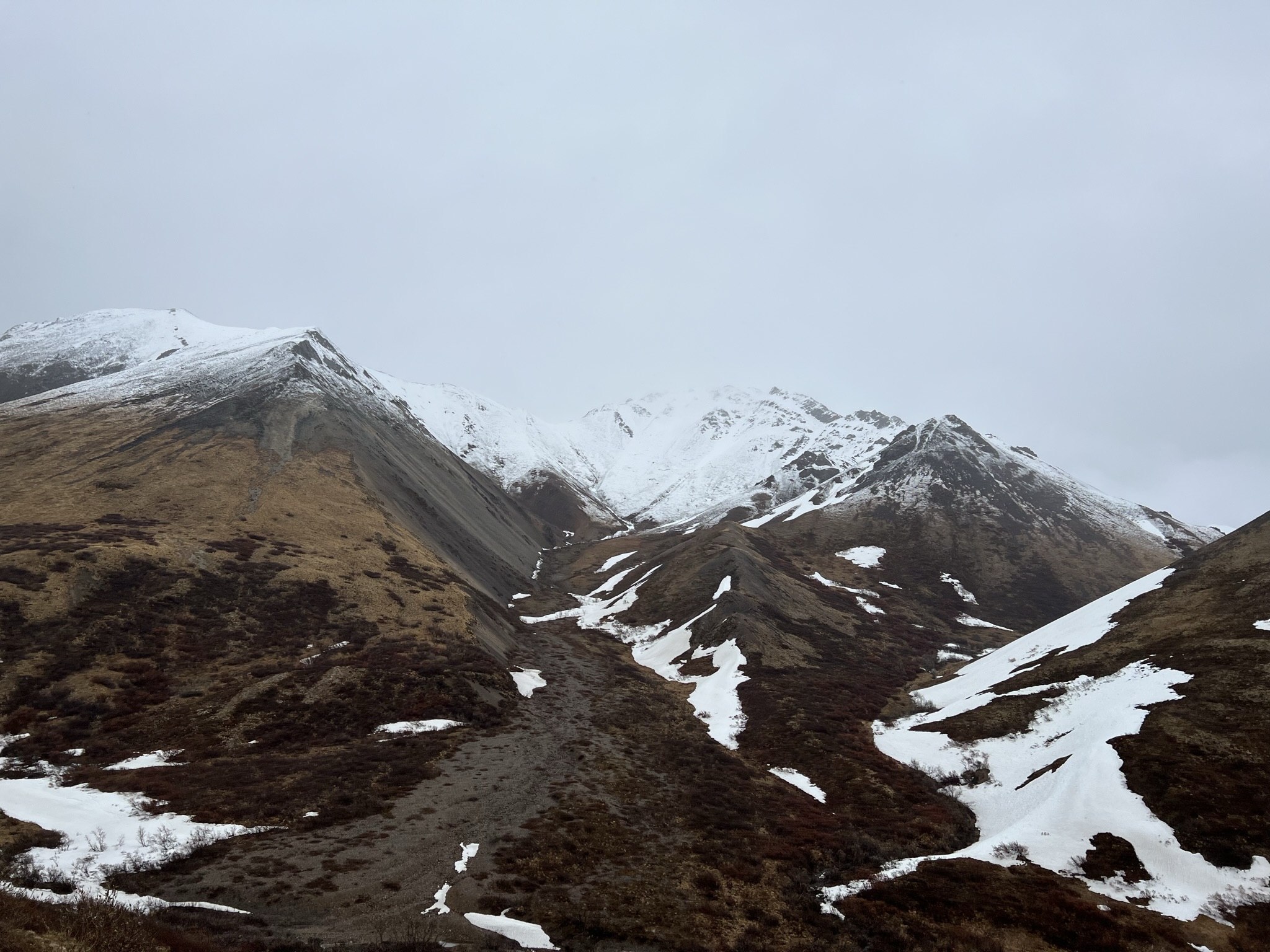
On my last day I only had the morning to do something since I had to catch the train back to Anchorage at noon. I decided to hike the Horseshoe Lake Trail again as it is a relatively short but amazing hike. Unfortunately, this time there was no beaver to see. After the hike it was time to grab my stuff and get on the train back to Anchorage, from where I started my last part of the trip to the Kenai Peninsula.
4. Kenai Peninsula
During my journey across the Kenai Peninsula, I explored three captivating destinations: Seward, Homer, and Whittier.
4.1 Homer
My first stop was Homer, known as the halibut capital where I stayed at the Driftwood Inn, a nice hotel right next to the beach. I joined a fishing tour with Homer Ocean Charters, setting off from the harbor located on a scenic spit. The harbor itself is a very nice area with a lot of small buildings on stilts.
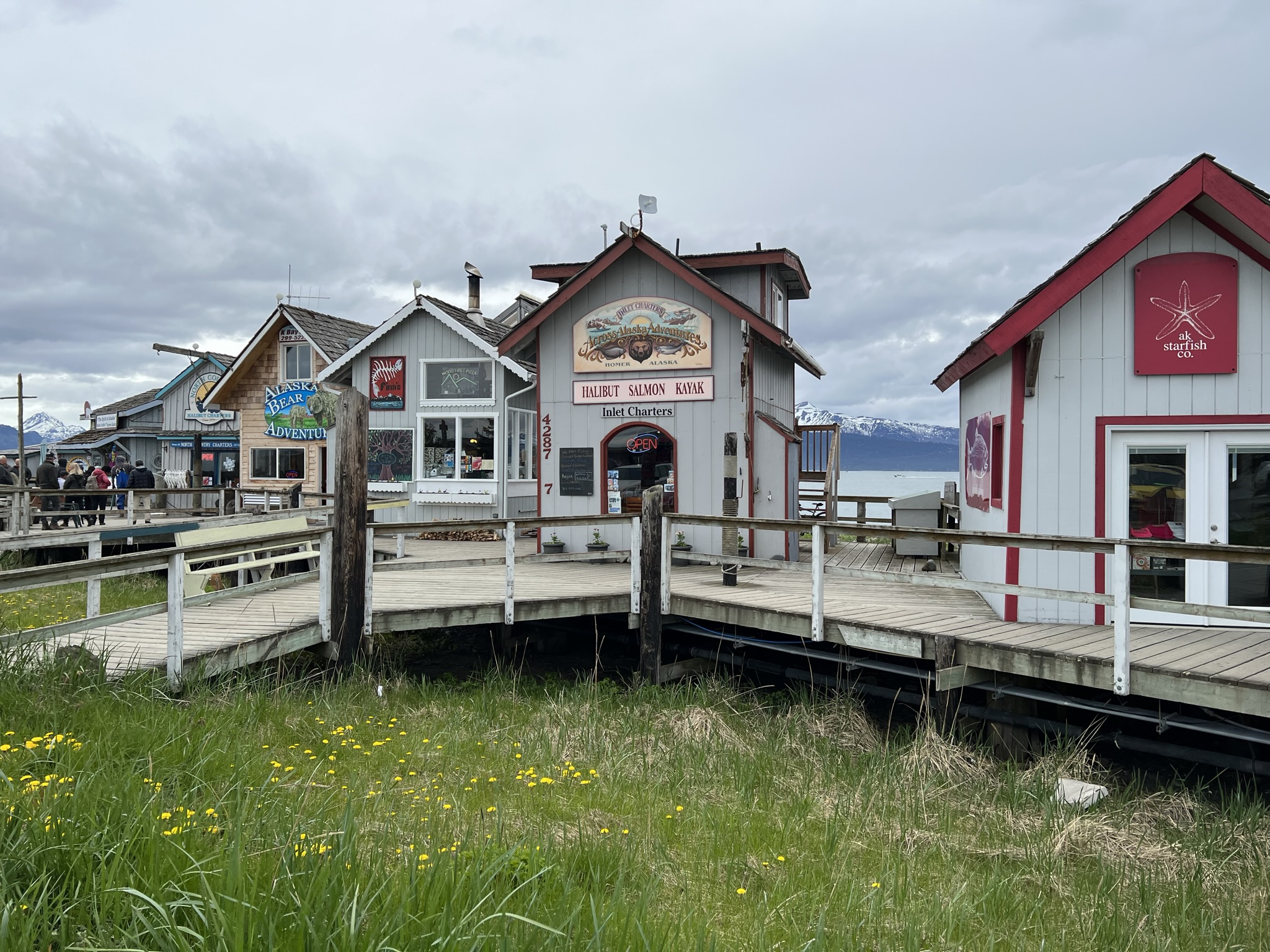
Harbor Homer
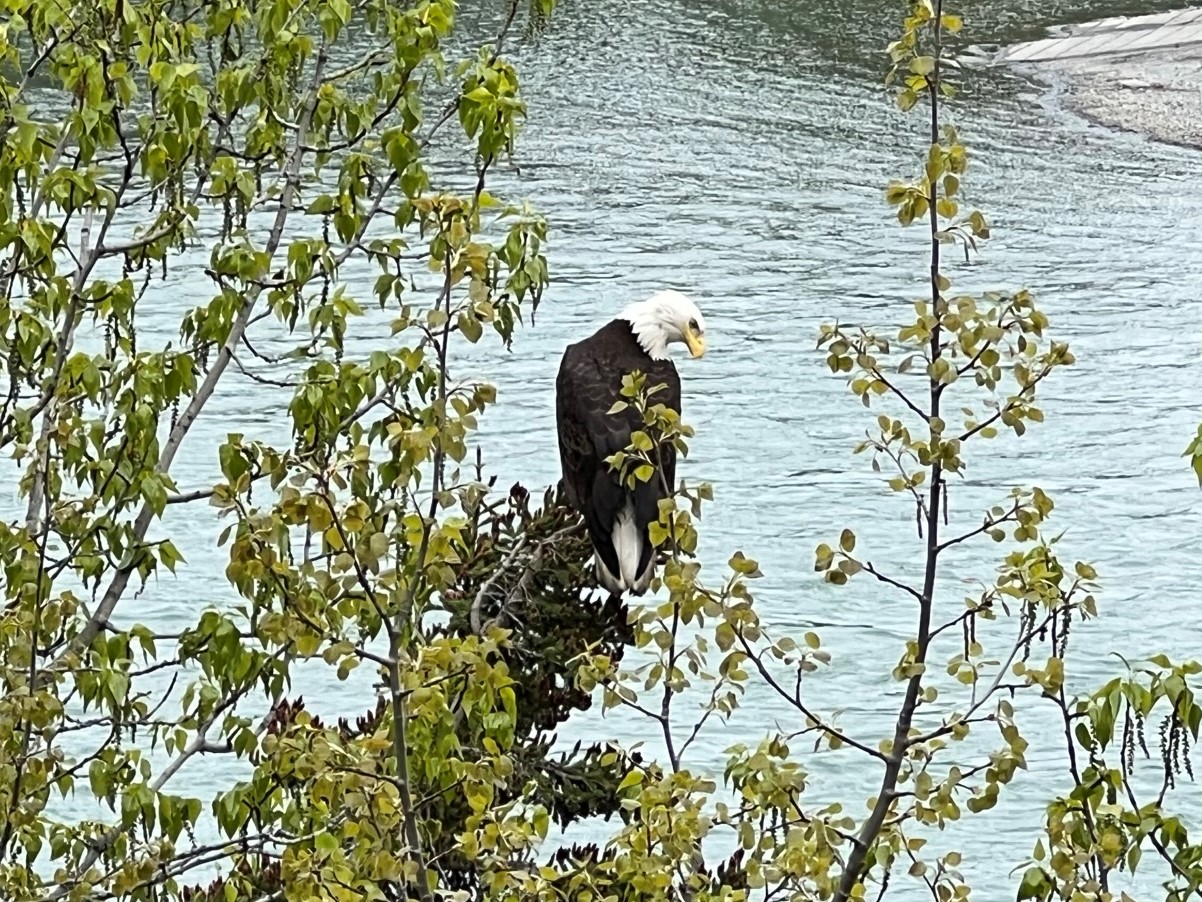
Bald Eagle
During the eight-hour tour, I experienced the thrill of reeling in numerous halibuts and even caught some Pacific cods. Another highlight was the incredible sight of orcas gracefully swimming in the waters. Considering the logistics of taking the fish back to Germany, I decided to share my catch with fellow anglers on the boat. They invited me over for dinner and we enjoyed the delicious fish together. Their house was on a small hill right next to a river and a bald eagle was sitting in a tree right in front of the window. It was amazing to see one of them so close.
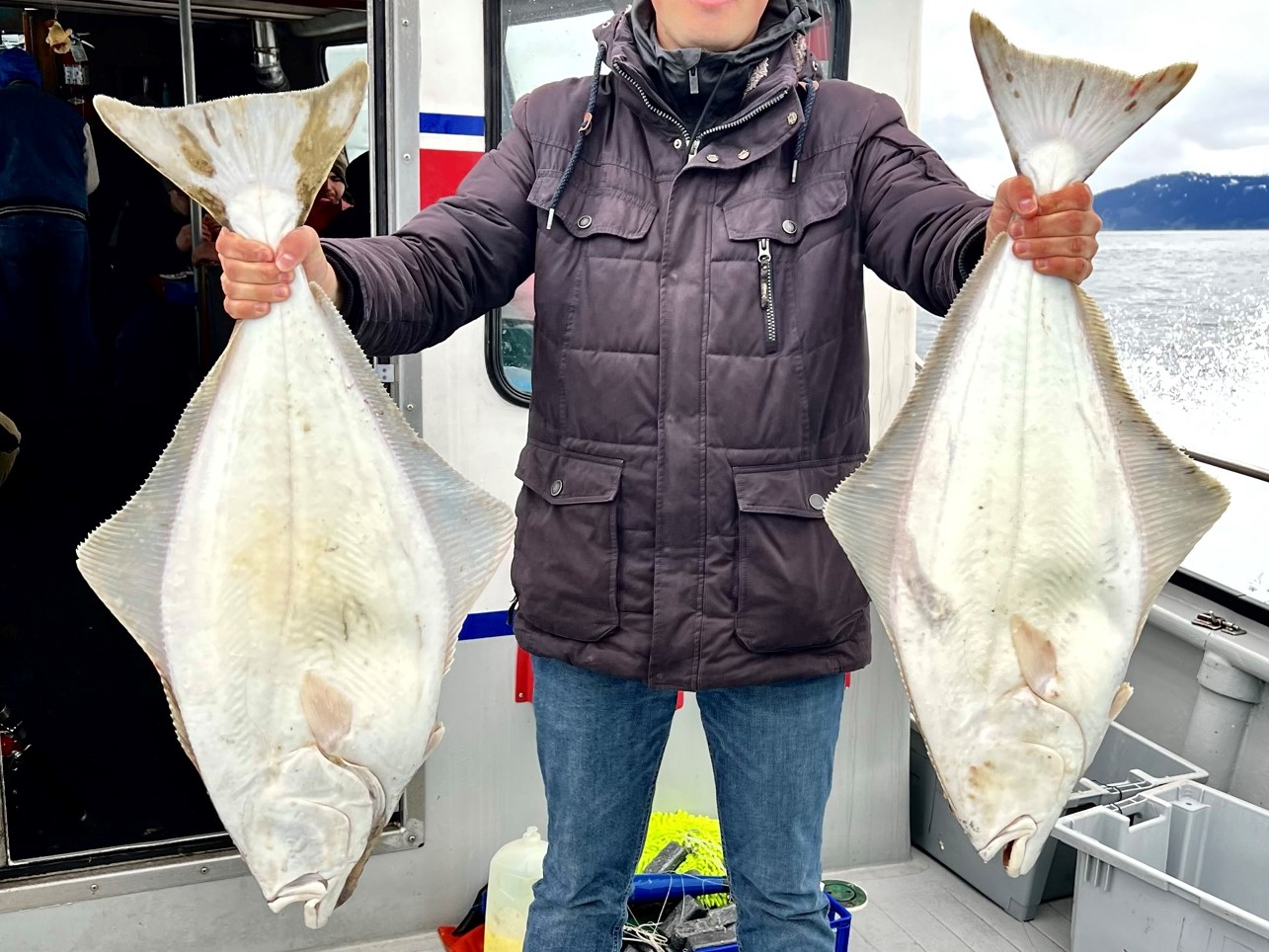
Halibut
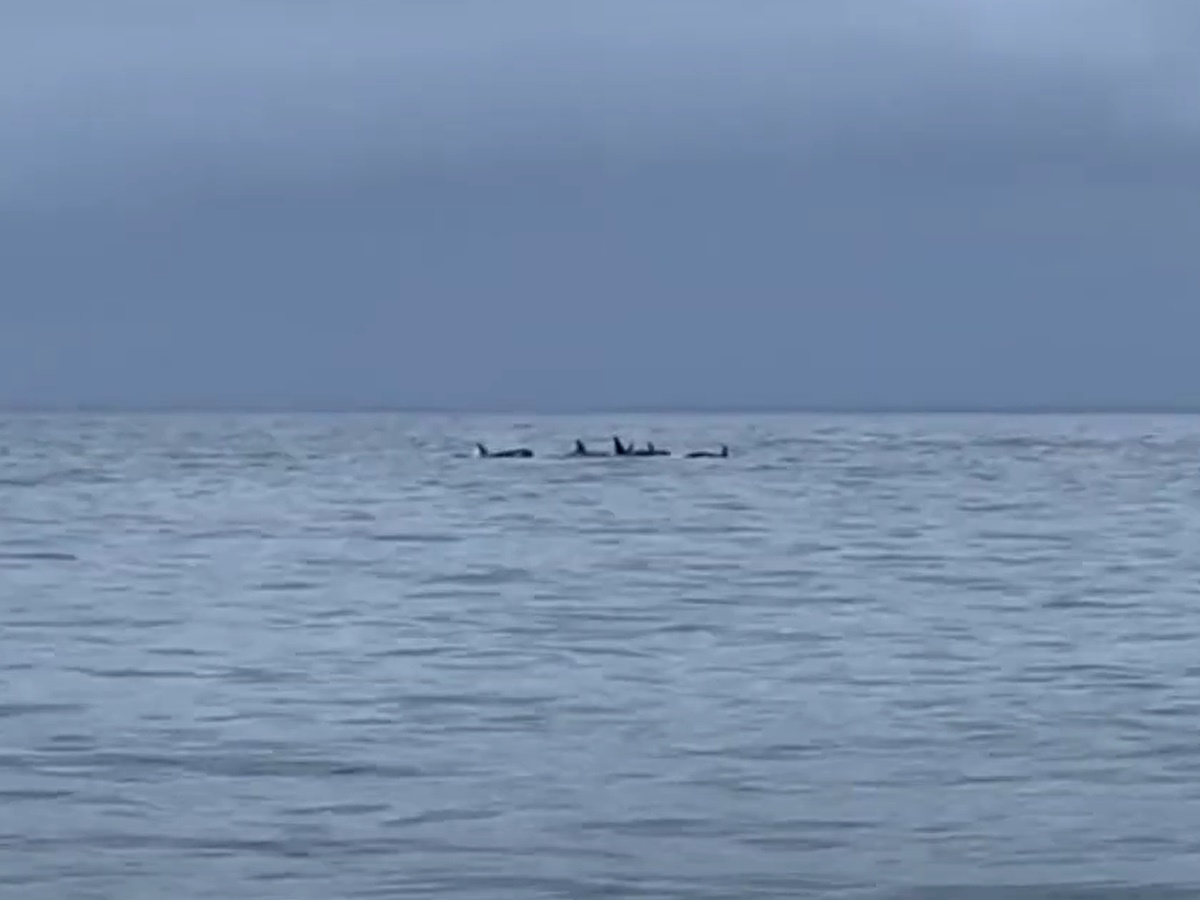
Orcas
4.2 Seward
From Homer I took the bus again to get to Seward, a small town at the end of a fjord. I stayed at the Nauti Otter Yurt Village, an idyllic retreat, surrounded by towering trees and tranquil nature located outside the town. However, I soon realized that my lack of a car posed a significant challenge, since there is no public transport and not even Uber. As a result, I had to hitchhike to get to downtown Seward.
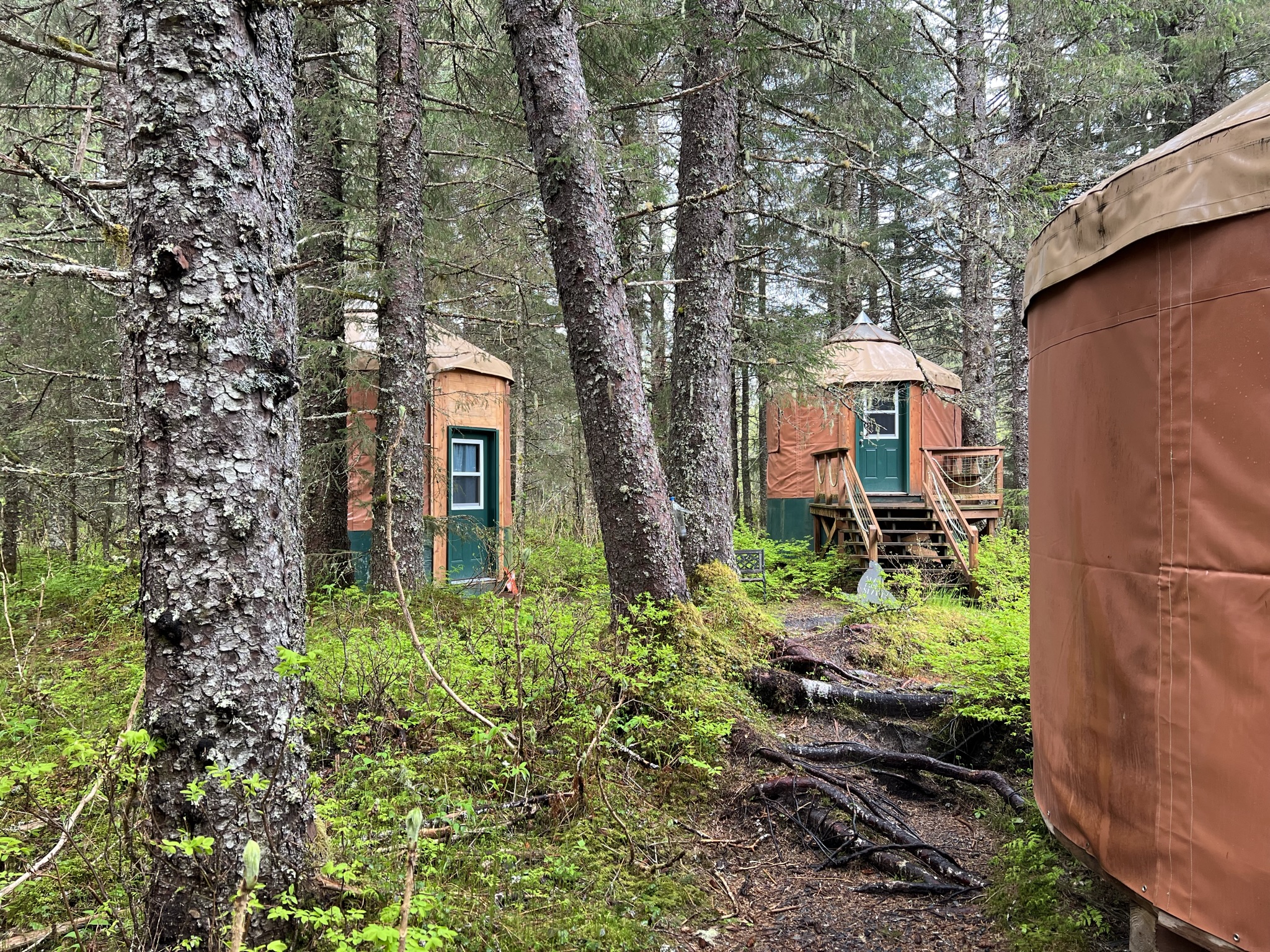
Nauti Otter Yurt Village

Seward Harbor
The first day led me to a boat tour through the majestic Kenai Fjords National Park. We set out on a planned journey, tracing the fjord's path, venturing into the Gulf of Alaska, and eventually reaching the glaciers. However, Mother Nature had different plans in store for us. Unfavorable weather conditions prevented us from crossing the treacherous waves of the Gulf, altering our itinerary.

Despite the unexpected turn of events, the tour still presented us with memorable experiences and breathtaking scenery. As we cruised along the fjords, a sense of tranquility enveloped us, showcasing the awe-inspiring beauty of the surroundings. We were treated to sightings of playful sea otters and an array of magnificent seabirds, providing glimpses into the rich marine life that thrived in these waters.


The true highlight of the tour was an awe-inspiring spectacle—a humpback whale gracefully breaching the water's surface, not once but twice. Witnessing the sheer power and grace of such a majestic creature was a moment of pure wonder, etching itself deeply into my memory.
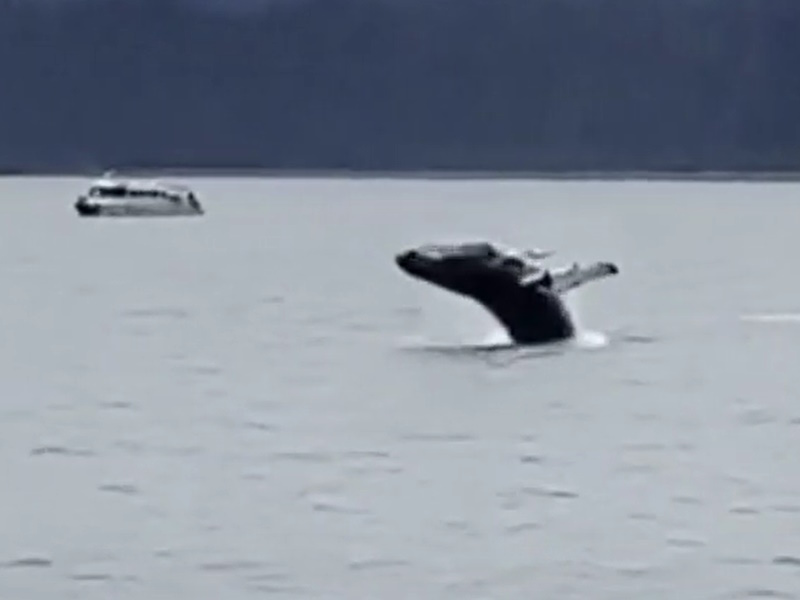
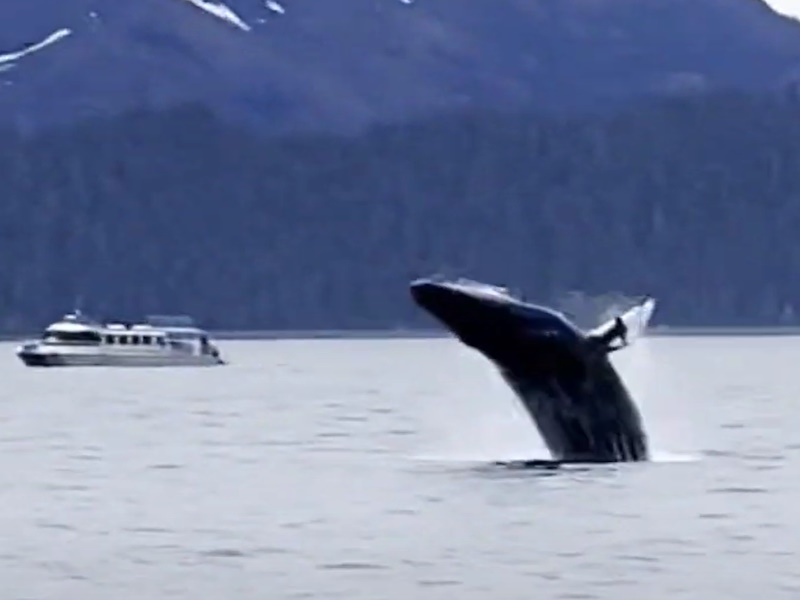
Our journey led us to Fox Island, a serene oasis amidst the fjords. Here, we indulged in a delightful lunch, which was originally planned as a dinner following our encounter with the glaciers. While the change in schedule frustrated me, it did not overshadow the delicious meal and the beauty of the island.
Regrettably, my disappointment grew when I reflected on the tour's handling of the situation. Prior to our departure, we were informed about the possibility of inclement weather and the chance that the glacier visit might be altered. In such cases, we were promised an alternative tour within the fjords. However, the reality fell short of expectations, as the tour turned out to be two hours shorter than anticipated, with no explanation or refund provided. Expressing my concerns to the staff at the check-in, I emphasized that the tour's shortfall in time was not communicated during the initial briefing. Disappointingly, their response shifted the responsibility onto me, suggesting that it was implied (but definitely not clearly stated). While I understand that inclement weather and miscommunication can occur, I believe it is crucial for tour operators to handle such situations appropriately and take accountability rather than placing the blame solely on the customer.
On my second day, I hitchhiked to the mesmerizing Exit Glacier. Upon my arrival, I embarked on a brief trail that led me directly to the glacier's majestic presence. Along this path, I had the opportunity to traverse the vast gravel bars that once lay beneath the glacier's imposing form. Witnessing the glacier's remarkable retreat over the past decades was truly captivating, aided by informative signs strategically placed along the trail, marking its historical positions.

Exit Glacier from the front
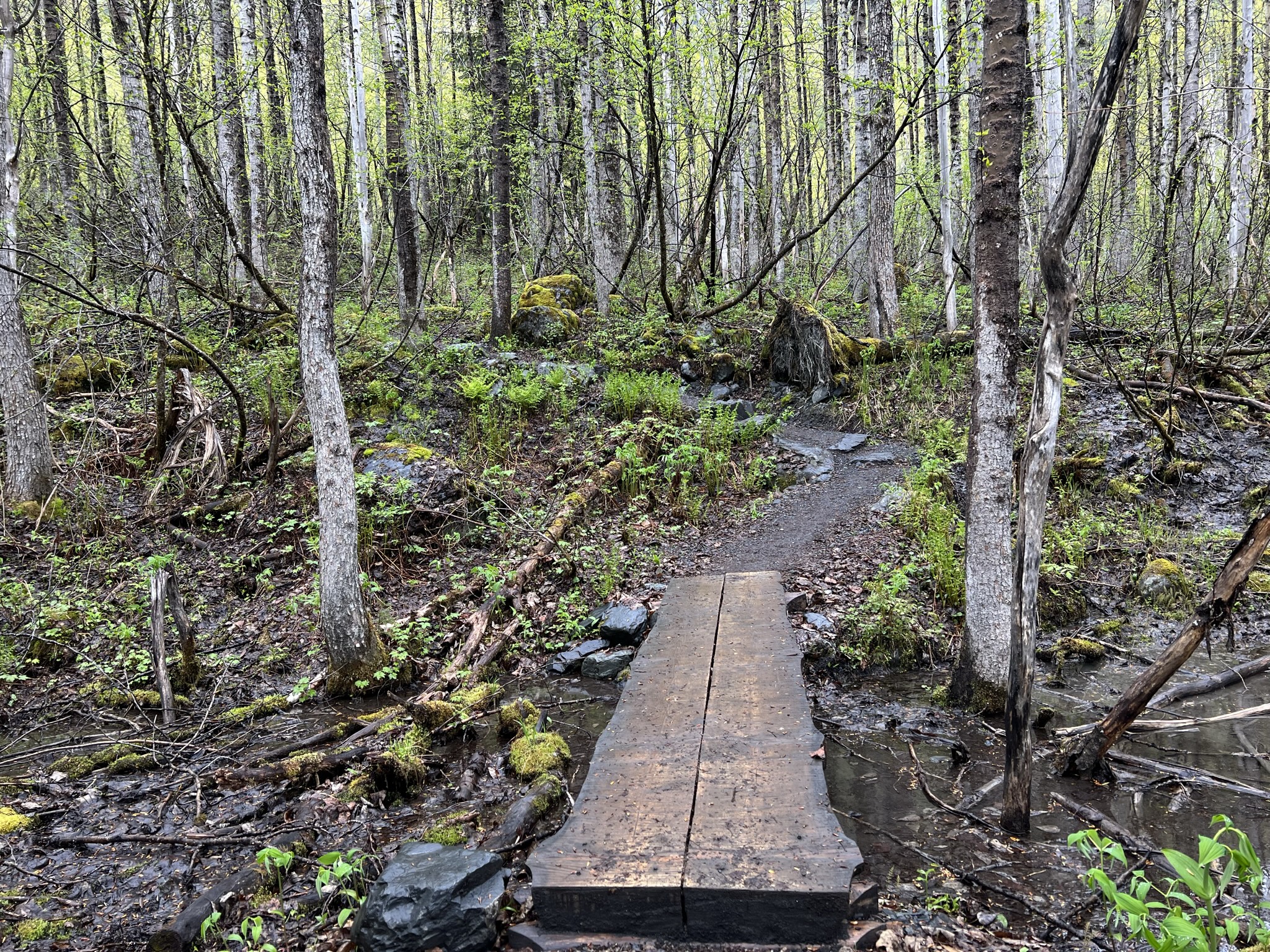
Hiking Trail
Eager to explore further, I took on the challenge of the Harding Icefield Trail. This trail, known for its steep inclines, beckoned me towards a breathtaking viewpoint showcasing the glacier and the encompassing mountains in all their splendor. As I ascended, the hike grew increasingly demanding, with the accumulation of snow presenting new obstacles. By the time I reached the first viewpoint, I found myself traversing deep snow, yet this proved to be the easier segment, merely a fraction of the entire journey.
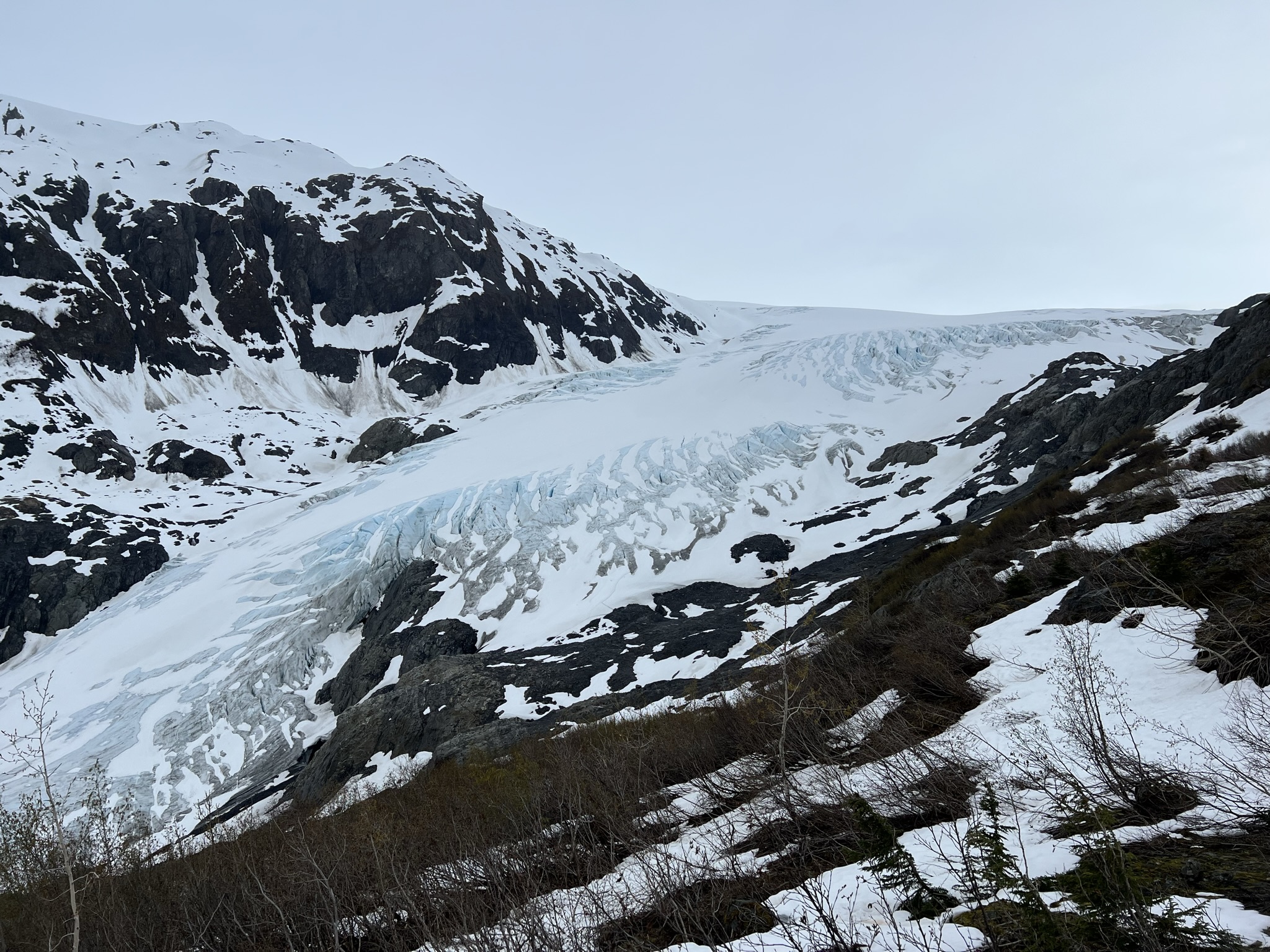
First Viewpoint
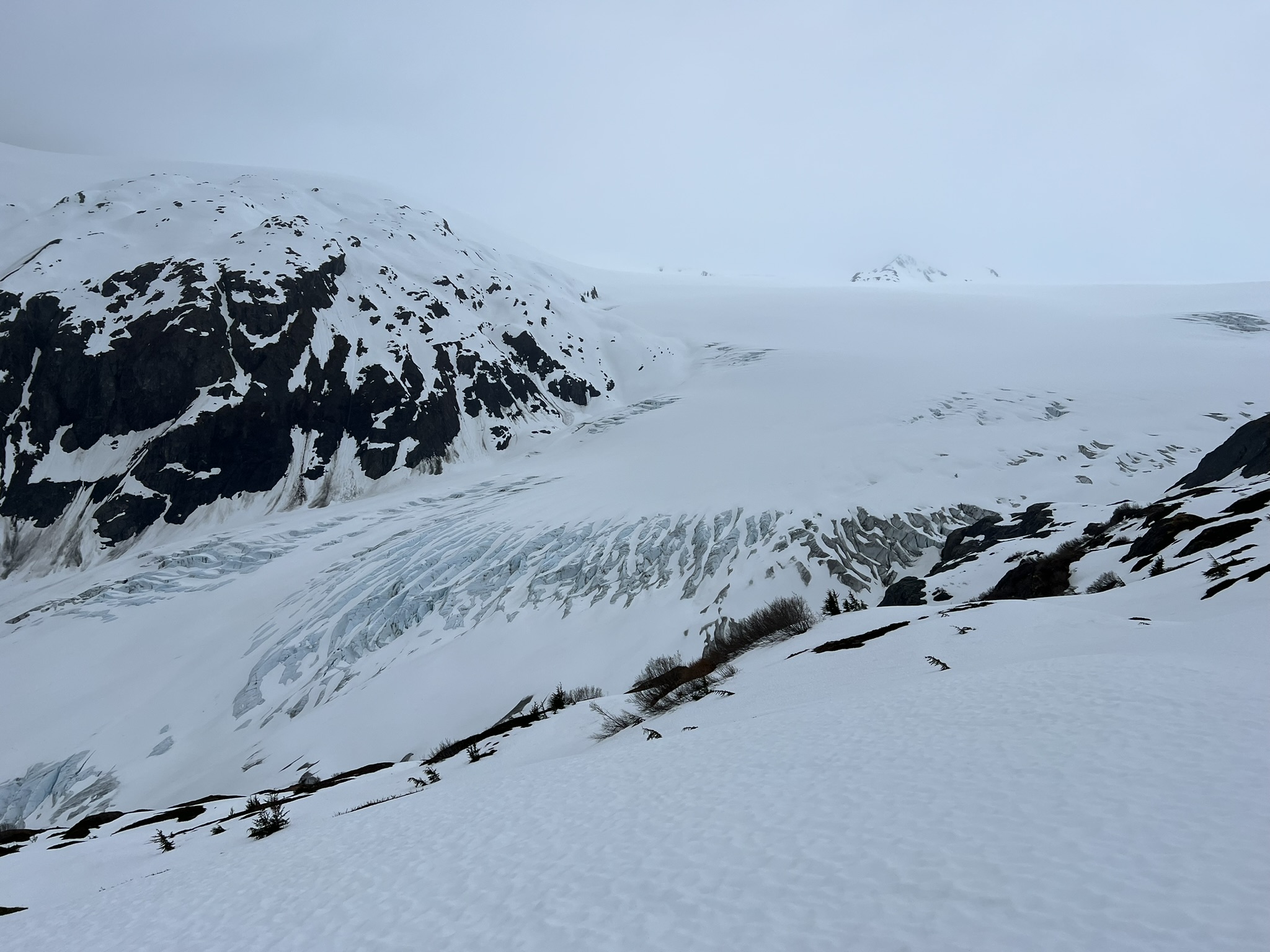
Second Viewpoint
Undeterred, I resolved to surpass the boundaries marked by the avalanche warning sign and pressed onward. Beyond a certain point, it became apparent that no hikers had ventured along this trail since the recent snowfall. Uncertain of the safe path, I forged my own route, steadily climbing the mountain in pursuit of the elusive second viewpoint. Though uncertainty lingered, I persevered, driven by the allure of the unknown.

At this point I decided to retrace my steps. With each step, I found myself sliding more than walking, relying on utmost caution to avoid getting ensnared or losing balance. In retrospect, this impulsive decision, undertaken without proper equipment such as hiking sticks, stands as the most audacious exploit of my Alaskan adventure. But I eventually made it back to the parking lot. I even saw a black bear (but unfortunately nothing more than something black moving in the bushes).
4.3 Whittier and the 26 Glacier Cruise
After bidding farewell to Seward, took a return bus to Anchorage, where I would spend my final two nights, marking the end of my Alaskan adventure. Anchorage also served as the launchpad for my last day trip. I opted for a comprehensive tour, which encompassed a bus ride from Anchorage to the town of Whittier, followed by the unforgettable 26 Glacier Cruise. The bus ride was an intriguing experience, as it traversed the longest tunnel in North America, though its narrowness demanded strict adherence to designated entrance times. The tunnel operated in a unidirectional manner, granting passage to trains first, before accommodating cars, and then repeating the process from the opposite direction.
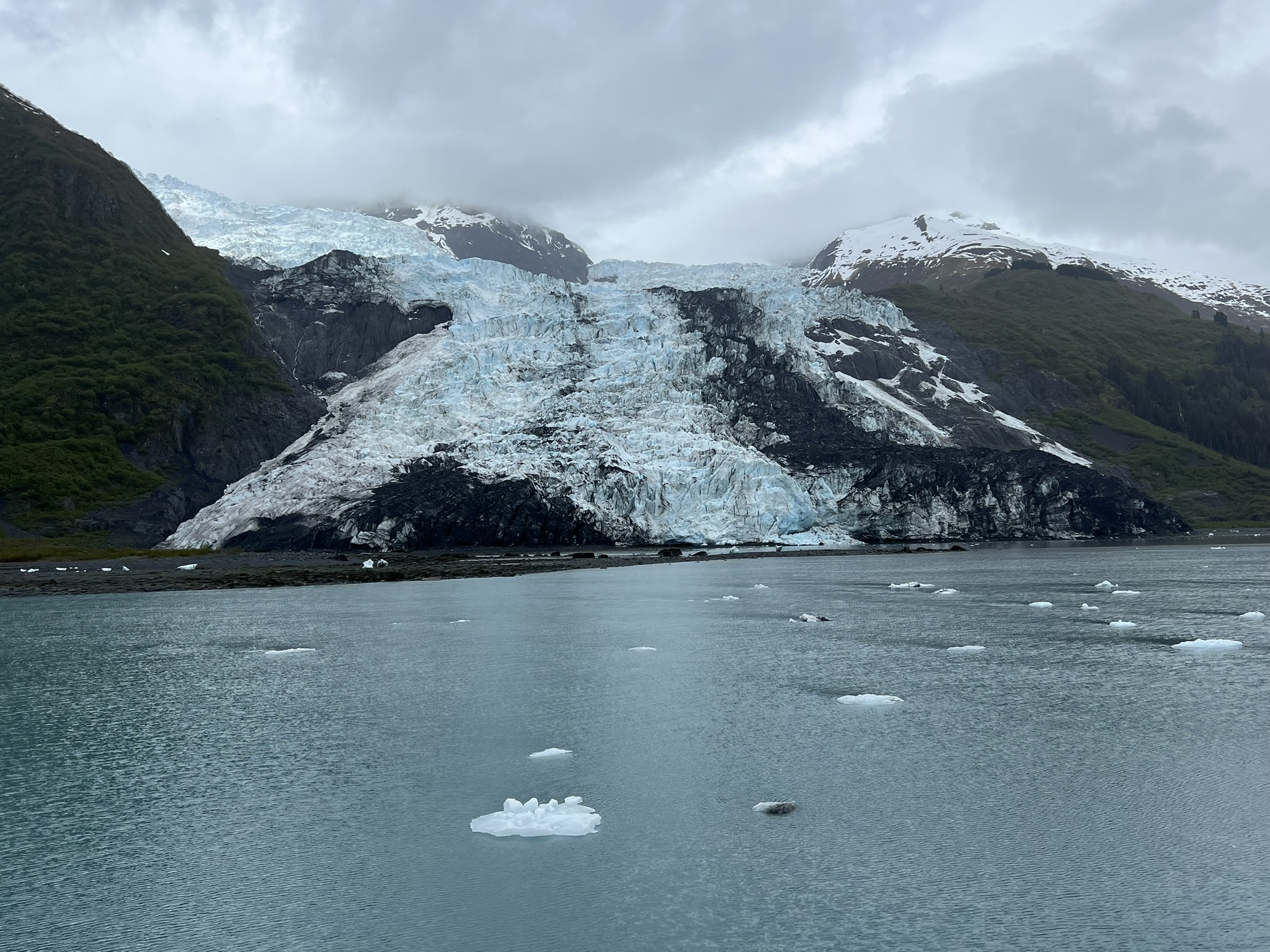
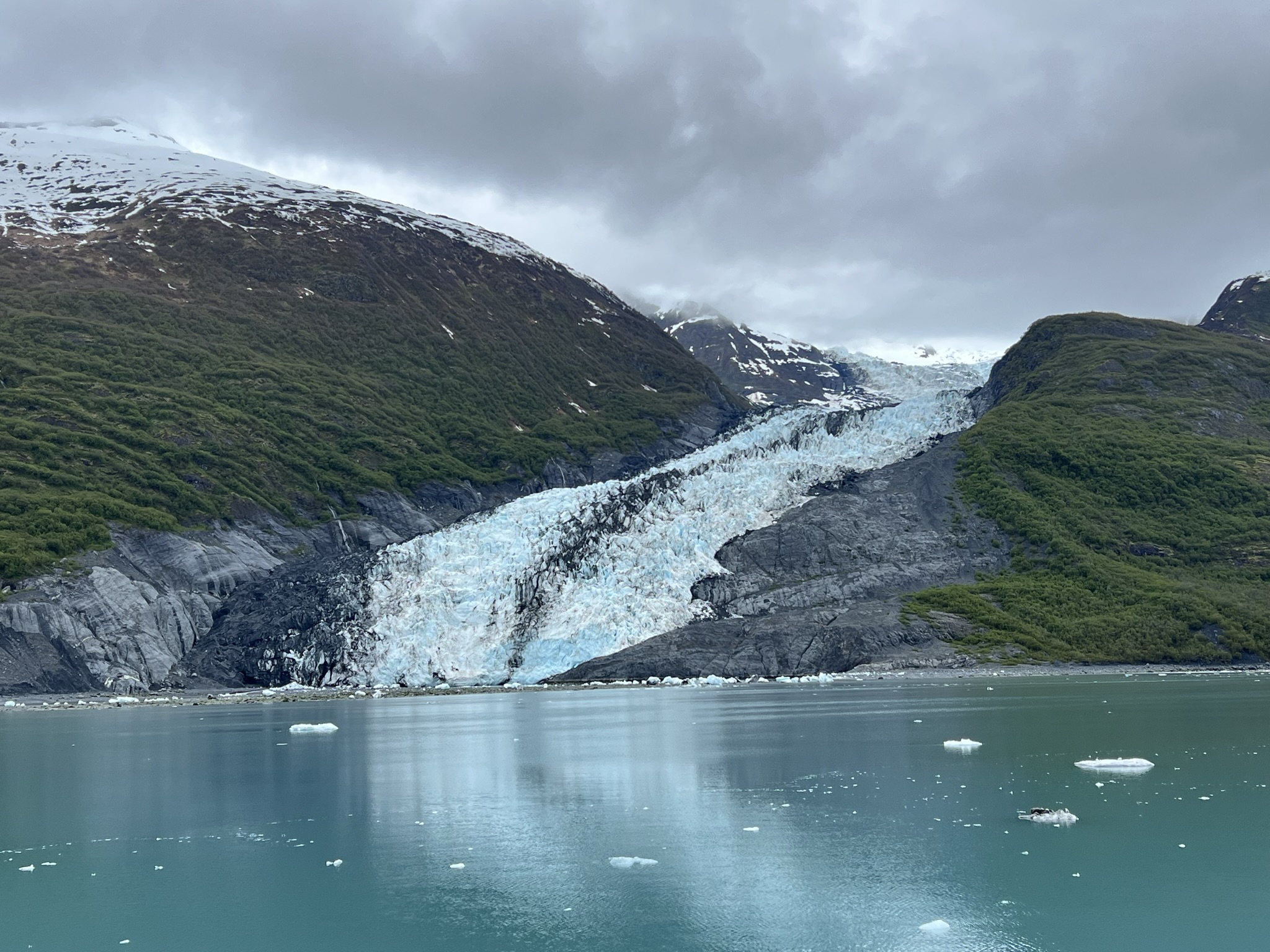
Shortly after boarding the boat lunch was served - it was okay. While we were eating, the captain made his way towards the first glaciers. The surface of the water became adorned with an increasing number of ice formations, compelling the captain to navigate our ship at a brisk pace, reaching an impressive 30 knots. As we ventured deeper into the icy waters, playful sea otters gracefully swam or lounged upon the floating ice, adding a touch of whimsy to the already enchanting scene. As our journey neared the majestic glacier, seals, in their natural habitat, graced us with their presence. While approaching the huge glacier at the end of this part of the fjord, we could already enjoy smaller, but still impressive, glaciers on the side.
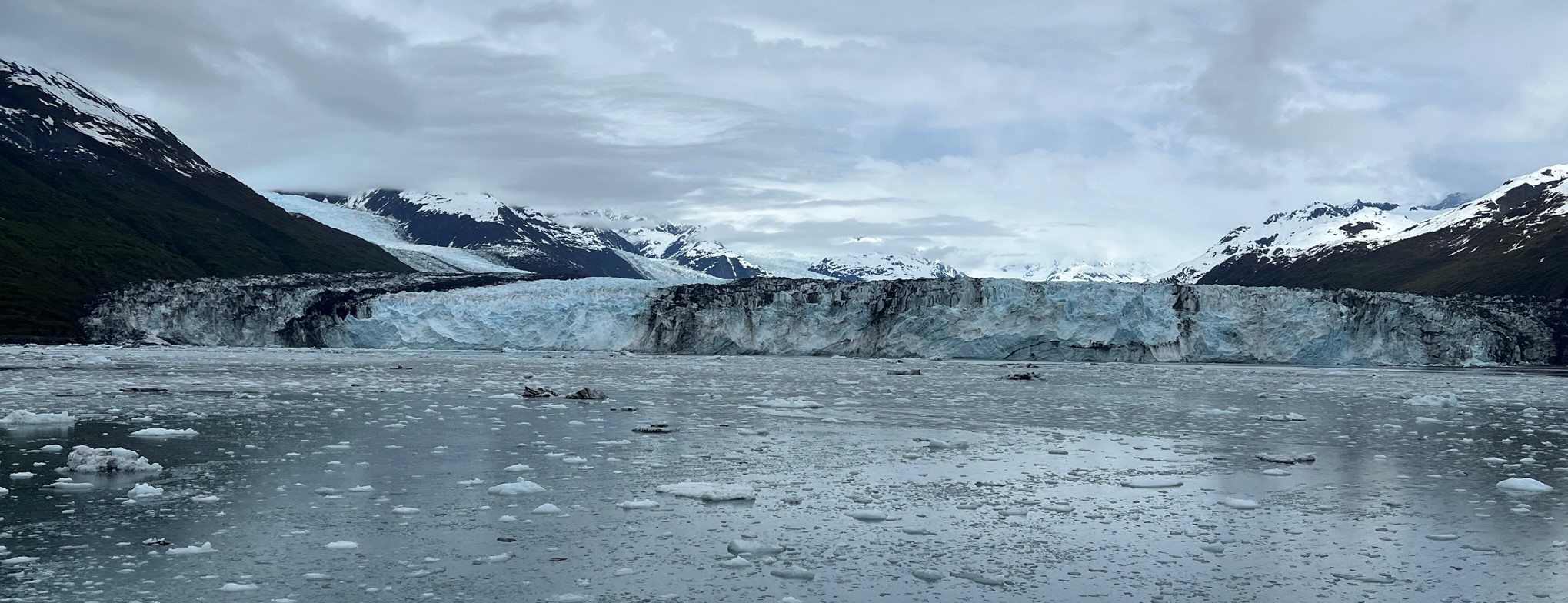
Standing in the presence of a colossal glacier for the very first time evoked a profound sense of humility within me. The sheer immensity of the glacier commanded awe and reverence, as it loomed above us, its grandeur unmatched. We were privileged to witness the mesmerizing phenomenon of glacier calving, accompanied by a resounding roar akin to thunder. The sound reverberated through the air, leaving an indelible impression on our senses. This encounter marked just the beginning of our exploration, as we eagerly anticipated further encounters with these magnificent icy giants.
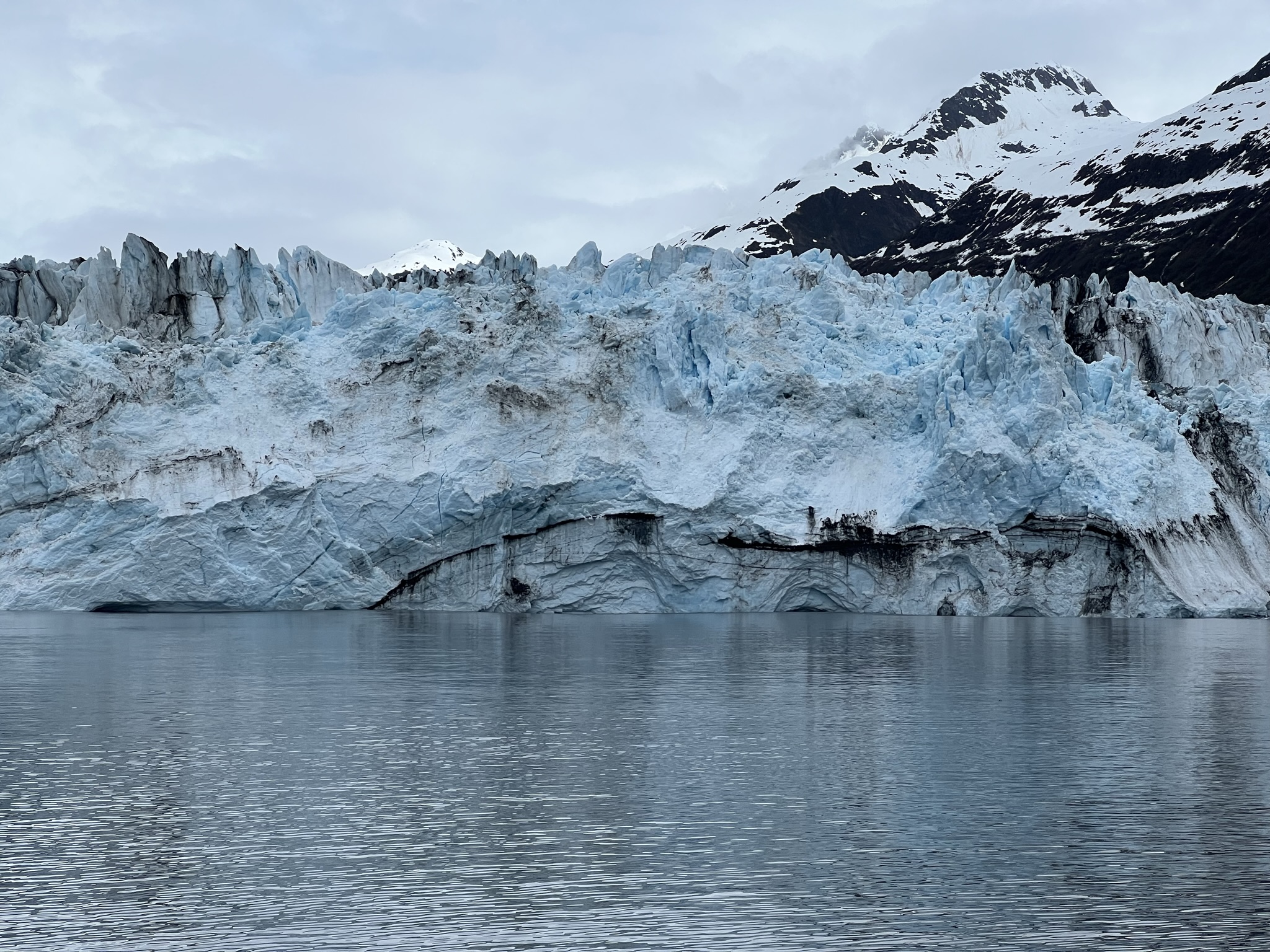
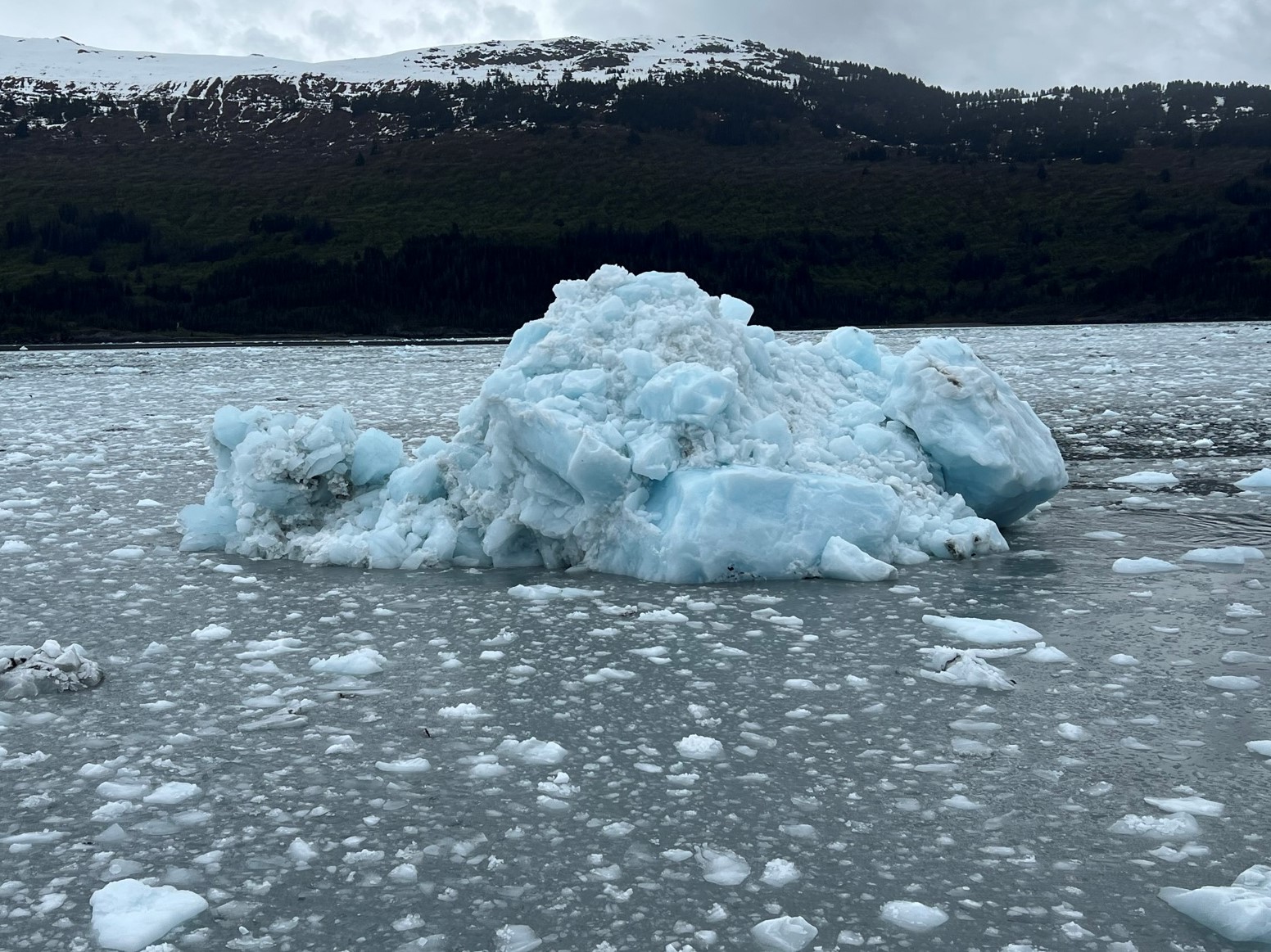
Leaving behind the first glacier, our journey led us through a narrow channel, flanked by breathtaking forests on both sides. The serene beauty of the surroundings provided a tranquil backdrop as we continued our exploration into other parts of the fjords, eager to discover more wonders. An intriguing aspect of our expedition was the stark contrast in weather conditions. While the main fjord boasted clear skies, as we ventured into smaller side passages, a veil of clouds descended, accompanied by gentle rain.
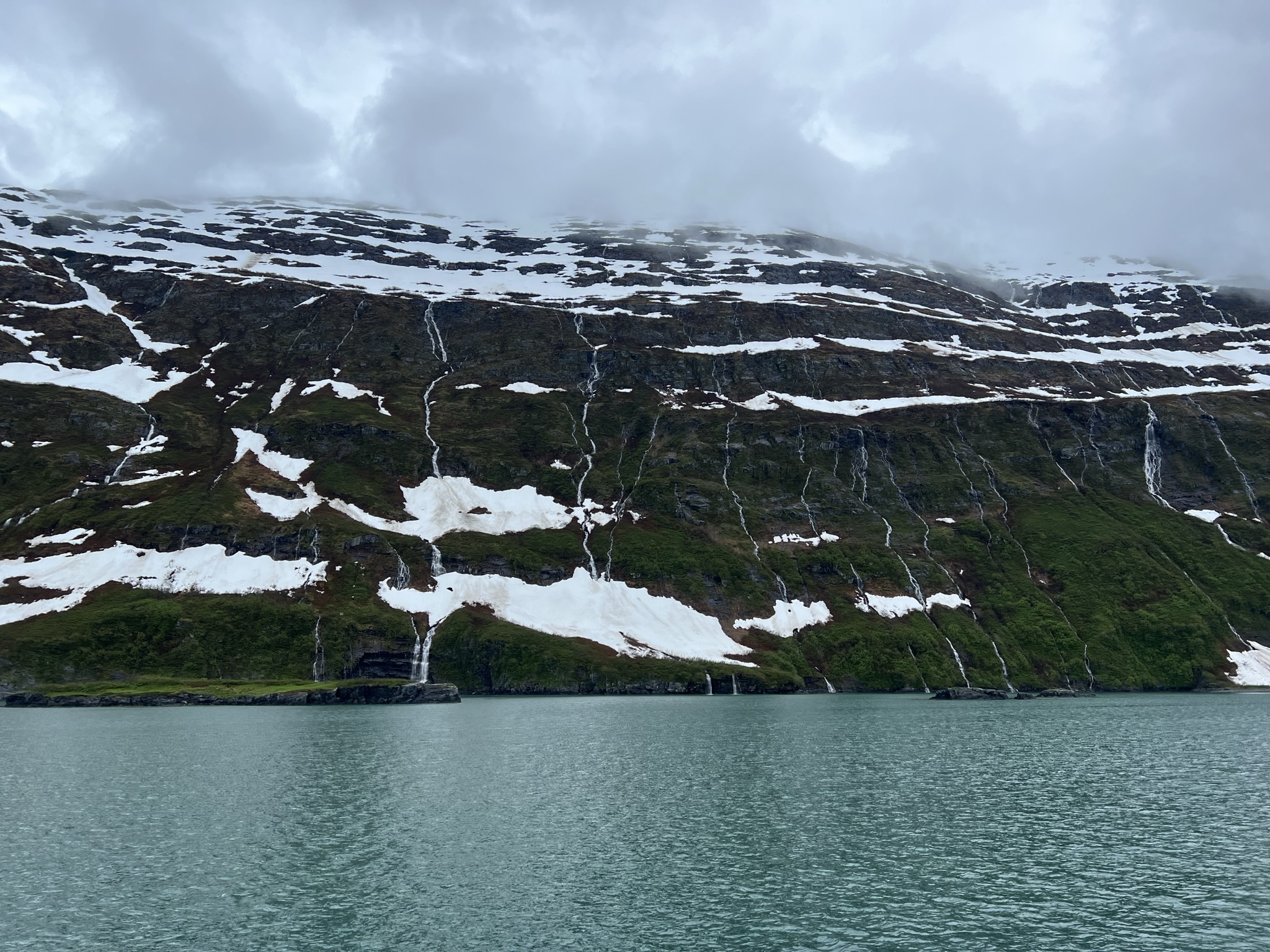

As we approached the next glacier, we could see a typical U-shaped valley, bearing the unmistakable traces of a retreating glacier. The glacier that awaited us, though narrower than its colossal predecessor, stood tall with unrivaled majesty. Its vertical expanse, soaring approximately 100 meters, defied description. No photograph or depiction could capture the true essence of its magnificence. Standing before it, we were filled with awe, marveling at the raw power and serene beauty that coexisted within this frozen behemoth.
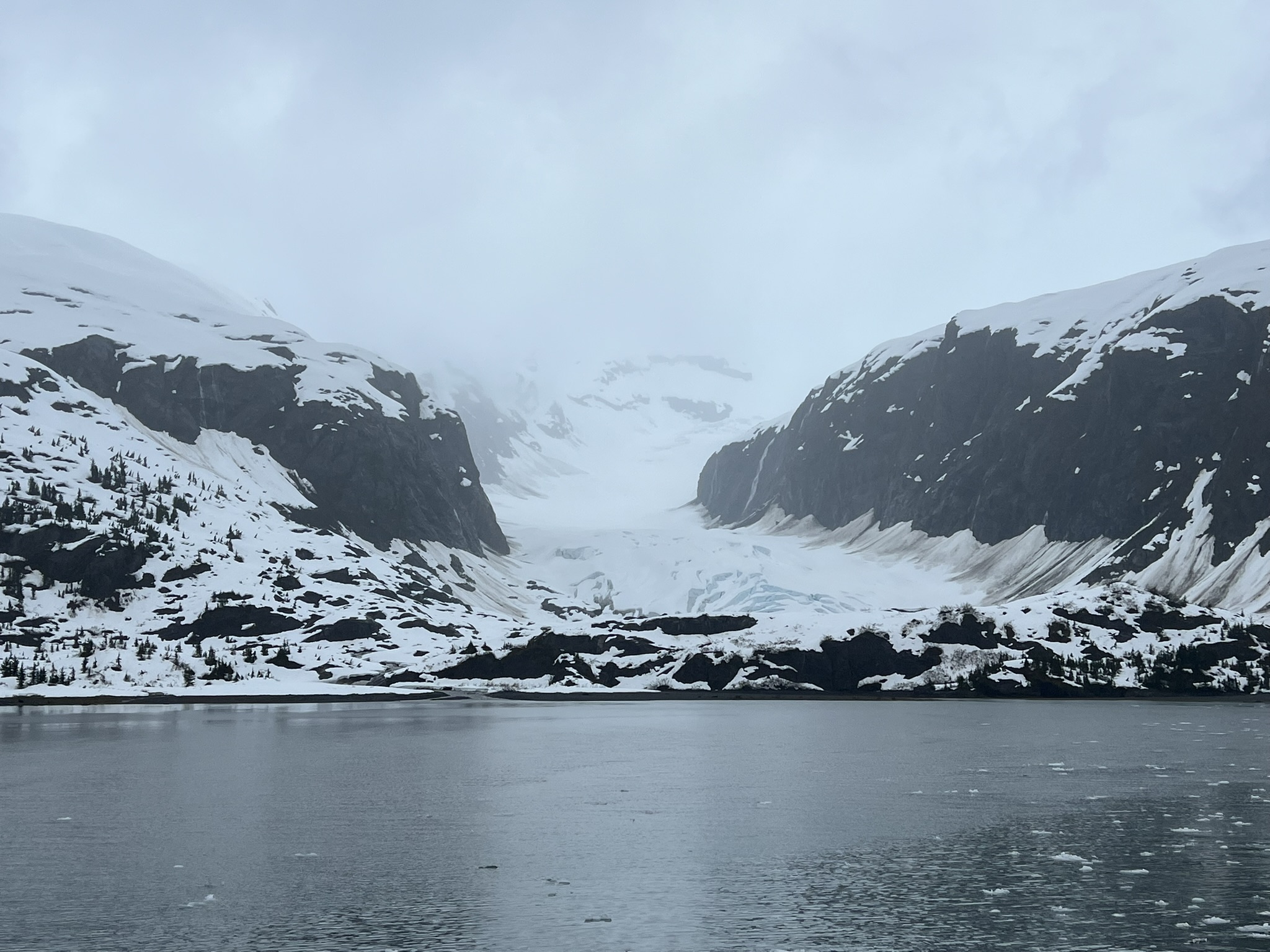

Our journey reached its culmination with the arrival at the last glacier on the tour, surpassing all expectations in its grandeur. Towering even higher than its predecessors, it boasted an additional spectacle—a magnificent waterfall cascading down its side, carrying with it the essence of melting ice. The presence of numerous birds added to the enchantment, as they gracefully glided through the air, perched upon the rocks, or floated atop ice fragments adrift in the water.

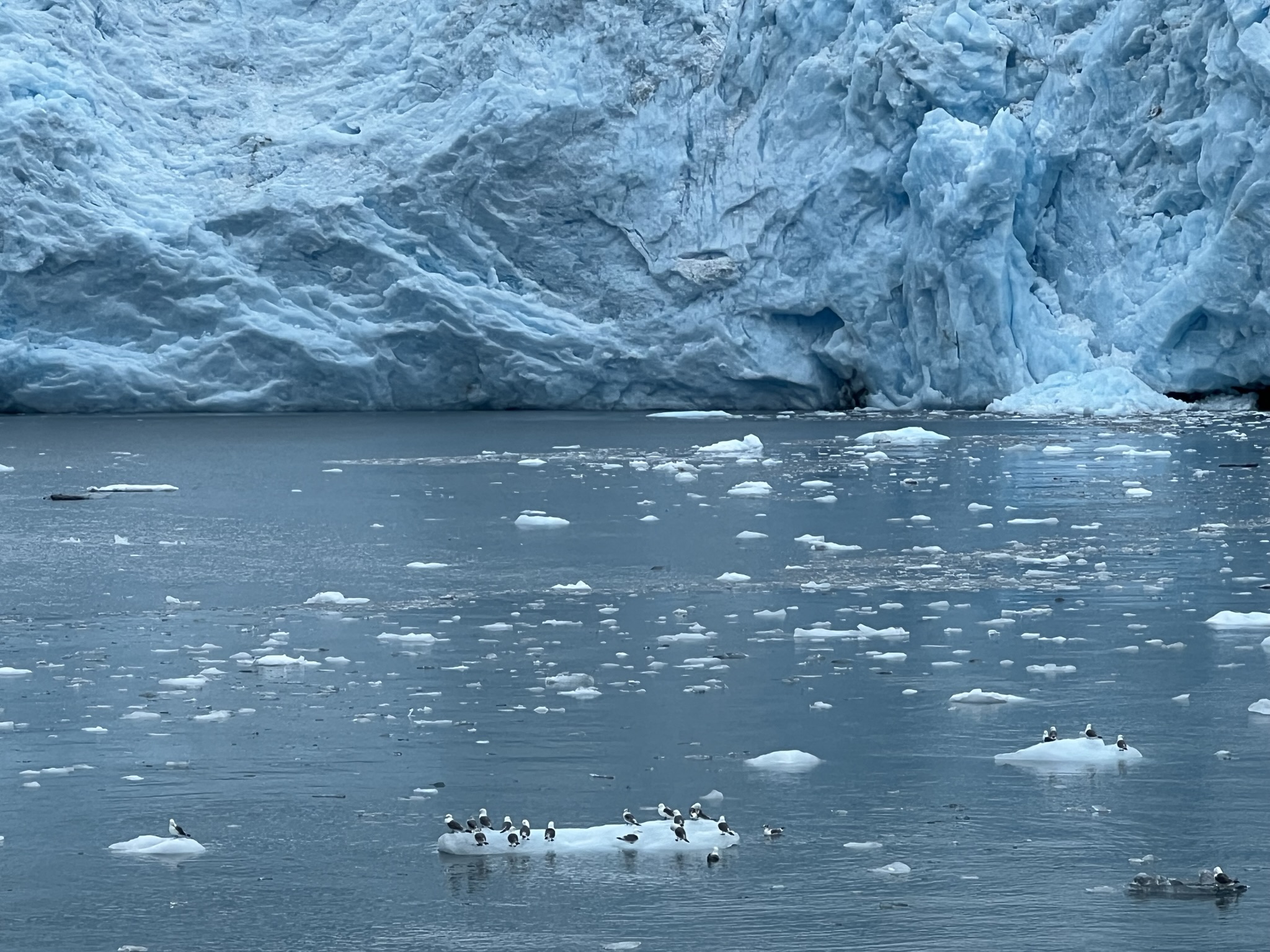

The final destination of our tour brought us to two magnificent waterfalls. What made this sight even more remarkable was the presence of tens of thousands of birds, finding sanctuary in the cliffs surrounding the waterfalls. The air was filled with their calls and the graceful movements of their wings, as they nested and soared in unison. We also spotted two mountain goats that perched upon the rocky precipices navigating the steep terrain with ease. Returning to the harbor, we embarked on the bus back to Anchorage.
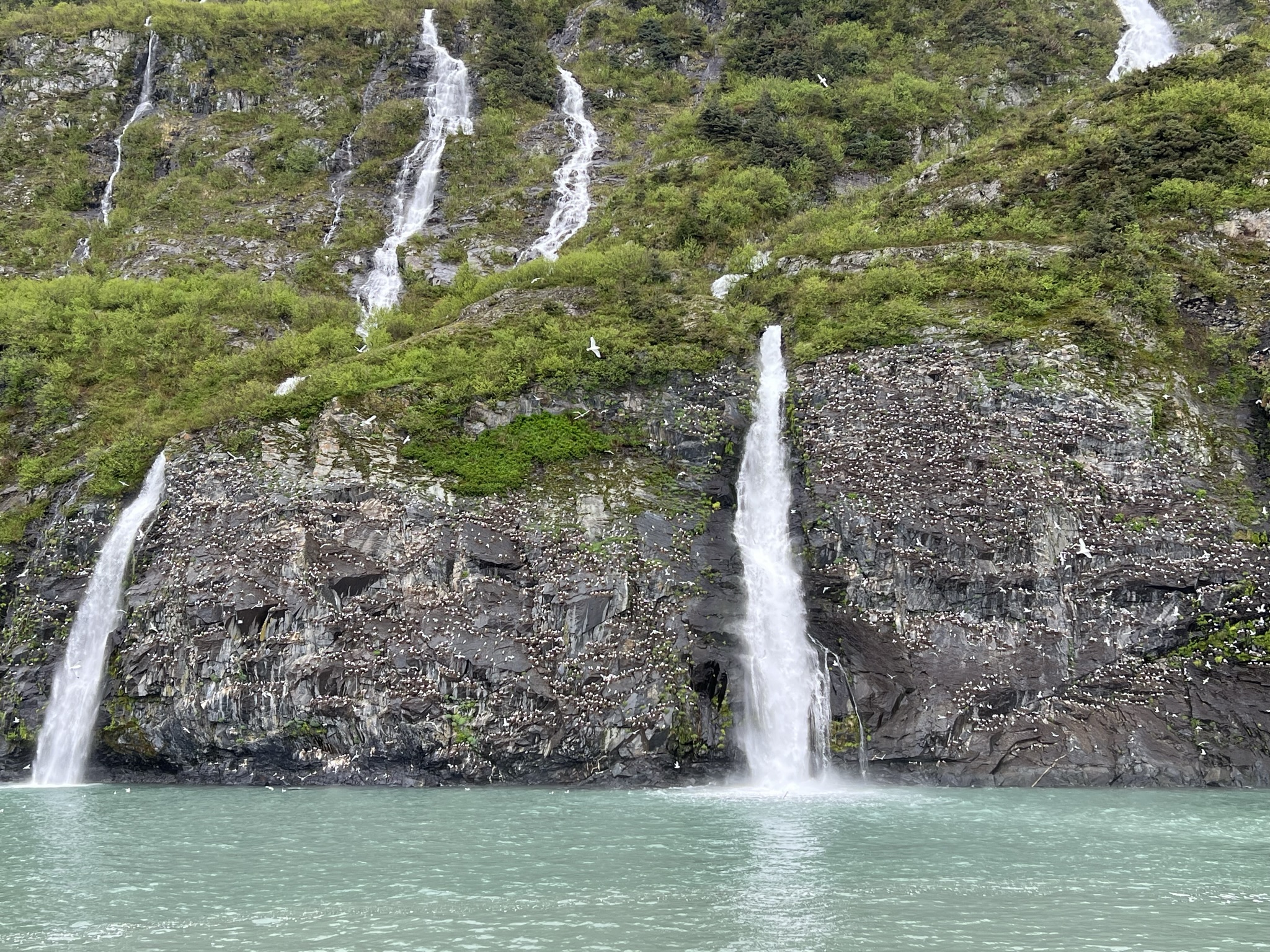
Waterfall surrounded by Birds

Mountain Goats